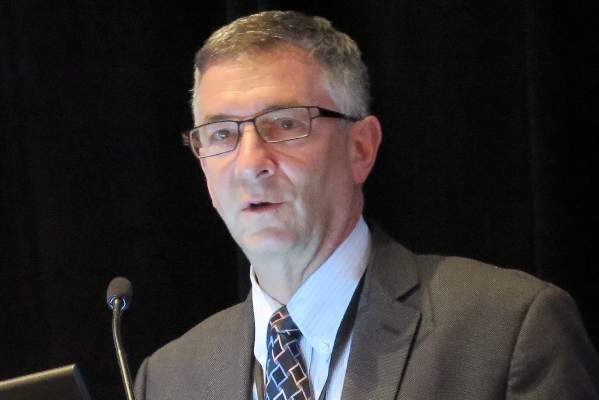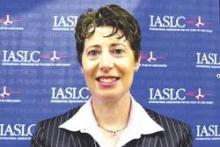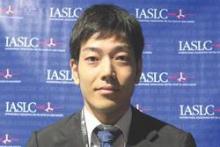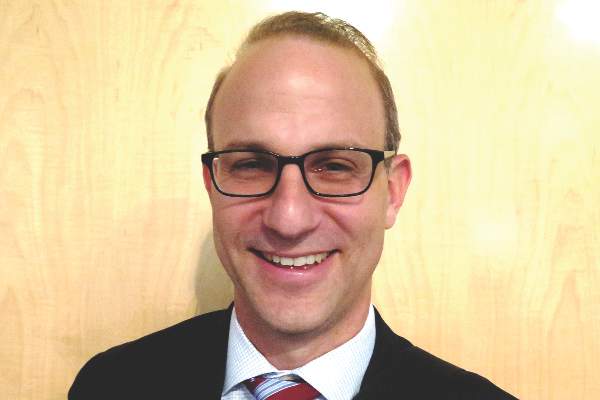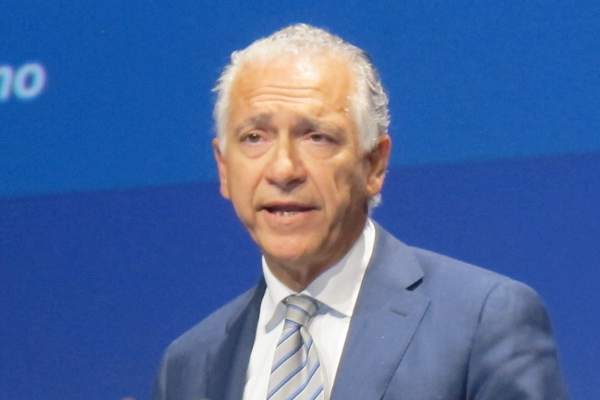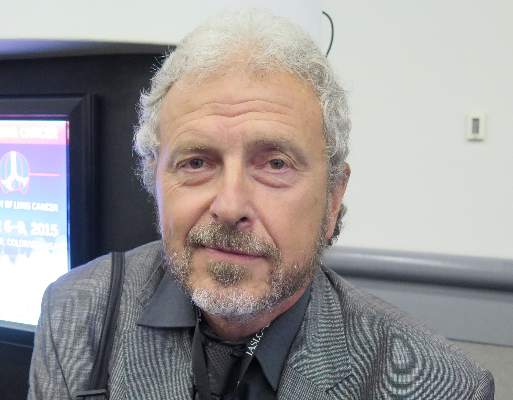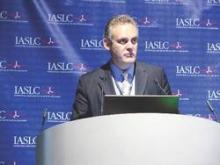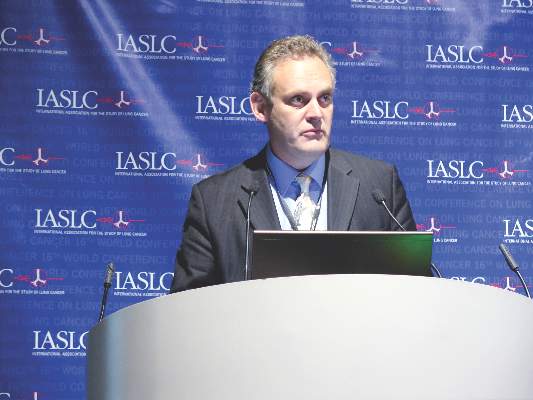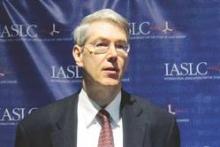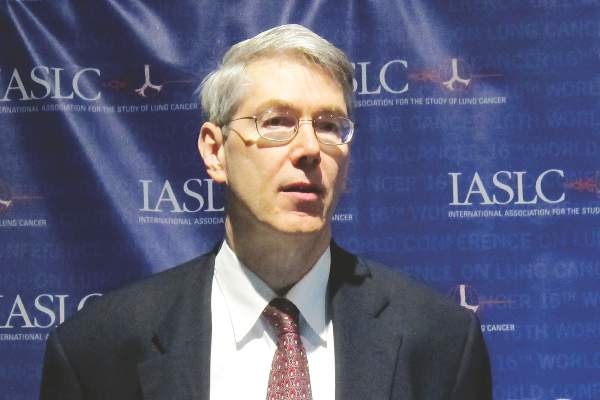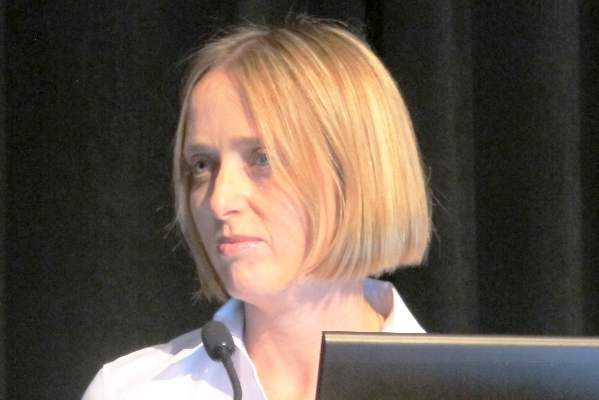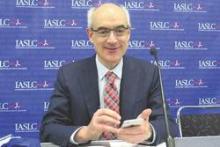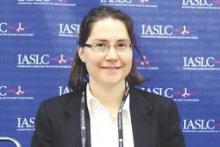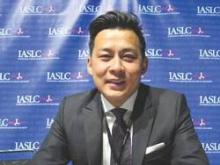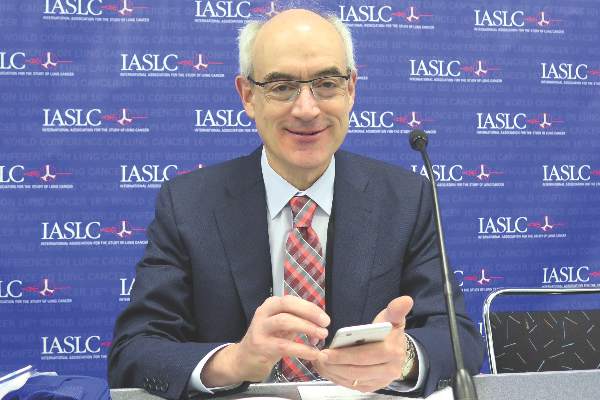User login
PD-L1 status of NSCLC consistent across primary, nodes, and metastases
DENVER – In patients with non–small cell lung cancer (NSCLC), the programmed death-ligand 1 (PD-L1) status of the primary tumor is generally a reliable predictor of the status of tumor elsewhere the body, suggest a pair of retrospective cohort studies presented at a world conference on lung cancer.
Results showed a high rate of concordance of PD-L1 immunohistochemical (IHC) staining, whether comparing primary with nodes (81%-89%) or primary with metastasis (77%), investigators reported.
These findings are relevant in that some studies have suggested that high PD-L1 expression is a biomarker for benefit from agents that inhibit the programmed cell death 1 (PD-1) signaling pathway. Thus, being able to use archival primary tumor to assess PD-L1 status might help guide decisions about treatment options in the metastatic setting.
“This is pretty good concordance, especially considering that our assays only have about 75% concordance [among them], depending on how you measure it and what cutpoints you use and which antibodies you use,” said invited discussant Dr. David Rimm, professor of pathology and of medicine, director of pathology tissue services, and director of translational pathology at Yale University in New Haven, Conn.
“The take-home message is, is the glass half full or is the glass half empty? And the real message is that maybe the glass is twice as big as it needs to be,” he said. “That is, what we really need to do is come up with a uniform assay here that’s standardized so that we can actually do studies like this a little more carefully.”
In the first study, Dr. Brandon S. Sheffield, of the pathology office at BC Cancer Agency, Vancouver, studied 78 patients who underwent resection of a primary nonsquamous NSCLC and were found to have nodal involvement.
For each patient, they compared PD-L1 staining between the primary tumor and the matched nodal tumor, simultaneously testing various antibodies; Bristol-Myers Squibb Canada performed some of the IHC. Tumors were considered positive if at least 1% of cells stained with any intensity.
Results showed an 81% rate of concordance of PD-L1 staining between the primary and node; in about 8% of cases, only the primary was positive, and in about 9%, only the node was positive.
Study results also showed good concordance across the three different antibodies: SP142 (Spring Bioscience), E1L3N (Cell Signaling Technology), and 28-8 (Dako). In 76% of cases, all three antibodies were in agreement.
In some cases, clusters of infiltrating macrophages stained for PD-L1. “This could represent a possible pitfall, especially using a cutoff as low as 1%, although with some practice, one can appreciate that the staining of macrophages is somewhat different than the crisp membranous staining seen in tumor cells,” Dr. Sheffield.
“PD-L1 IHC is feasible and it can be done in your laboratory. There are small but very relevant differences in testing primary tumor tissue and lymph node metastasis, and that will need to be explored with a bias toward testing more, not less, tissue,” he concluded. “Multiple methods for PD-L1 IHC appear to be equivalent, and we should be able to have some freedom in choosing the best PD-L1 IHC assay for our own laboratories.”
In the second study, Dr. Paul Mitchell of Austin Health, Melbourne, and colleagues assessed PD-L1 staining among 433 sequential patients who underwent resection of primary NSCLC between 1992 and 2010. Bristol-Myers Squibb performed the IHC staining and some of the scoring.
In one set of assays, the investigators used the 28.8 antibody and considered tumors to be positive if at least 5% of cells showed membranous staining of any intensity.
Results here showed that 28% of primaries were PD-L1 positive. The rate was similar for men and women, but higher in squamous tumors than in adenocarcinomas (39% vs. 18%). It was merely 14% in patients having an epidermal growth factor receptor (EGFR) mutation. The rate of positivity increased with the number of pack-years of smoking and, starting 5 years after cessation, decreased over time.
A total of 57 patients had paired primary tumor and metastatic tumor (most commonly from brain metastases). The median time from primary to metastasis was 1.3 years; in eight patients, metastasis was synchronous.
In this cohort, there was a 77% rate of concordance of PD-L1 staining between the primary and metastasis (r = 0.37, P = .0049); in 11% of cases, only the primary was positive, and in 12%, only the metastasis was positive. Also, among the eight patients having multiple metastases, all samples were concordant in six patients.
In another set of assays, the investigators used the E11340 XP antibody (Cell Signaling Technology) and considered tumors to be strongly positive if more than 50% of cells stained with intensity of 2 or higher (ASCO 2015, abstract 11051).
Here, 24% of primaries were strongly positive. In a multivariate analysis, patients with stage III disease who had high PD-L1 expression in both the primary and node had better disease-free survival (hazard ratio, 0.49; P = .031) and overall survival (HR, 0.46; P = .006).
Among the 53 patients who had paired primary and nodal tumor, PD-L1 staining was concordant in these sites in 89% of patients.
“These data do suggest that PD-L1 status in general in the primary NSCLC predicts the PD-L1 status in metastases as well as in the nodes,” Dr. Mitchell said. “However, if the PD-L1 expression status is critical in the decision to treat metastatic NSCLC with a PD-1 pathway inhibitor, then rebiopsy of a metastasis may be warranted,” he added.
Dr. Sheffield reported that he had no relevant disclosures; Bristol-Myers Squibb Canada performed some of the IHC staining. Dr. Mitchell disclosed ties with AstraZeneca, Roche, Boehringer-Ingelheim, Bristol-Myers Squibb, and MSD. Bristol-Myers Squibb performed IHC staining and some of the scoring.
The conference was sponsored by the International Association for the Study of Lung Cancer.
DENVER – In patients with non–small cell lung cancer (NSCLC), the programmed death-ligand 1 (PD-L1) status of the primary tumor is generally a reliable predictor of the status of tumor elsewhere the body, suggest a pair of retrospective cohort studies presented at a world conference on lung cancer.
Results showed a high rate of concordance of PD-L1 immunohistochemical (IHC) staining, whether comparing primary with nodes (81%-89%) or primary with metastasis (77%), investigators reported.
These findings are relevant in that some studies have suggested that high PD-L1 expression is a biomarker for benefit from agents that inhibit the programmed cell death 1 (PD-1) signaling pathway. Thus, being able to use archival primary tumor to assess PD-L1 status might help guide decisions about treatment options in the metastatic setting.
“This is pretty good concordance, especially considering that our assays only have about 75% concordance [among them], depending on how you measure it and what cutpoints you use and which antibodies you use,” said invited discussant Dr. David Rimm, professor of pathology and of medicine, director of pathology tissue services, and director of translational pathology at Yale University in New Haven, Conn.
“The take-home message is, is the glass half full or is the glass half empty? And the real message is that maybe the glass is twice as big as it needs to be,” he said. “That is, what we really need to do is come up with a uniform assay here that’s standardized so that we can actually do studies like this a little more carefully.”
In the first study, Dr. Brandon S. Sheffield, of the pathology office at BC Cancer Agency, Vancouver, studied 78 patients who underwent resection of a primary nonsquamous NSCLC and were found to have nodal involvement.
For each patient, they compared PD-L1 staining between the primary tumor and the matched nodal tumor, simultaneously testing various antibodies; Bristol-Myers Squibb Canada performed some of the IHC. Tumors were considered positive if at least 1% of cells stained with any intensity.
Results showed an 81% rate of concordance of PD-L1 staining between the primary and node; in about 8% of cases, only the primary was positive, and in about 9%, only the node was positive.
Study results also showed good concordance across the three different antibodies: SP142 (Spring Bioscience), E1L3N (Cell Signaling Technology), and 28-8 (Dako). In 76% of cases, all three antibodies were in agreement.
In some cases, clusters of infiltrating macrophages stained for PD-L1. “This could represent a possible pitfall, especially using a cutoff as low as 1%, although with some practice, one can appreciate that the staining of macrophages is somewhat different than the crisp membranous staining seen in tumor cells,” Dr. Sheffield.
“PD-L1 IHC is feasible and it can be done in your laboratory. There are small but very relevant differences in testing primary tumor tissue and lymph node metastasis, and that will need to be explored with a bias toward testing more, not less, tissue,” he concluded. “Multiple methods for PD-L1 IHC appear to be equivalent, and we should be able to have some freedom in choosing the best PD-L1 IHC assay for our own laboratories.”
In the second study, Dr. Paul Mitchell of Austin Health, Melbourne, and colleagues assessed PD-L1 staining among 433 sequential patients who underwent resection of primary NSCLC between 1992 and 2010. Bristol-Myers Squibb performed the IHC staining and some of the scoring.
In one set of assays, the investigators used the 28.8 antibody and considered tumors to be positive if at least 5% of cells showed membranous staining of any intensity.
Results here showed that 28% of primaries were PD-L1 positive. The rate was similar for men and women, but higher in squamous tumors than in adenocarcinomas (39% vs. 18%). It was merely 14% in patients having an epidermal growth factor receptor (EGFR) mutation. The rate of positivity increased with the number of pack-years of smoking and, starting 5 years after cessation, decreased over time.
A total of 57 patients had paired primary tumor and metastatic tumor (most commonly from brain metastases). The median time from primary to metastasis was 1.3 years; in eight patients, metastasis was synchronous.
In this cohort, there was a 77% rate of concordance of PD-L1 staining between the primary and metastasis (r = 0.37, P = .0049); in 11% of cases, only the primary was positive, and in 12%, only the metastasis was positive. Also, among the eight patients having multiple metastases, all samples were concordant in six patients.
In another set of assays, the investigators used the E11340 XP antibody (Cell Signaling Technology) and considered tumors to be strongly positive if more than 50% of cells stained with intensity of 2 or higher (ASCO 2015, abstract 11051).
Here, 24% of primaries were strongly positive. In a multivariate analysis, patients with stage III disease who had high PD-L1 expression in both the primary and node had better disease-free survival (hazard ratio, 0.49; P = .031) and overall survival (HR, 0.46; P = .006).
Among the 53 patients who had paired primary and nodal tumor, PD-L1 staining was concordant in these sites in 89% of patients.
“These data do suggest that PD-L1 status in general in the primary NSCLC predicts the PD-L1 status in metastases as well as in the nodes,” Dr. Mitchell said. “However, if the PD-L1 expression status is critical in the decision to treat metastatic NSCLC with a PD-1 pathway inhibitor, then rebiopsy of a metastasis may be warranted,” he added.
Dr. Sheffield reported that he had no relevant disclosures; Bristol-Myers Squibb Canada performed some of the IHC staining. Dr. Mitchell disclosed ties with AstraZeneca, Roche, Boehringer-Ingelheim, Bristol-Myers Squibb, and MSD. Bristol-Myers Squibb performed IHC staining and some of the scoring.
The conference was sponsored by the International Association for the Study of Lung Cancer.
DENVER – In patients with non–small cell lung cancer (NSCLC), the programmed death-ligand 1 (PD-L1) status of the primary tumor is generally a reliable predictor of the status of tumor elsewhere the body, suggest a pair of retrospective cohort studies presented at a world conference on lung cancer.
Results showed a high rate of concordance of PD-L1 immunohistochemical (IHC) staining, whether comparing primary with nodes (81%-89%) or primary with metastasis (77%), investigators reported.
These findings are relevant in that some studies have suggested that high PD-L1 expression is a biomarker for benefit from agents that inhibit the programmed cell death 1 (PD-1) signaling pathway. Thus, being able to use archival primary tumor to assess PD-L1 status might help guide decisions about treatment options in the metastatic setting.
“This is pretty good concordance, especially considering that our assays only have about 75% concordance [among them], depending on how you measure it and what cutpoints you use and which antibodies you use,” said invited discussant Dr. David Rimm, professor of pathology and of medicine, director of pathology tissue services, and director of translational pathology at Yale University in New Haven, Conn.
“The take-home message is, is the glass half full or is the glass half empty? And the real message is that maybe the glass is twice as big as it needs to be,” he said. “That is, what we really need to do is come up with a uniform assay here that’s standardized so that we can actually do studies like this a little more carefully.”
In the first study, Dr. Brandon S. Sheffield, of the pathology office at BC Cancer Agency, Vancouver, studied 78 patients who underwent resection of a primary nonsquamous NSCLC and were found to have nodal involvement.
For each patient, they compared PD-L1 staining between the primary tumor and the matched nodal tumor, simultaneously testing various antibodies; Bristol-Myers Squibb Canada performed some of the IHC. Tumors were considered positive if at least 1% of cells stained with any intensity.
Results showed an 81% rate of concordance of PD-L1 staining between the primary and node; in about 8% of cases, only the primary was positive, and in about 9%, only the node was positive.
Study results also showed good concordance across the three different antibodies: SP142 (Spring Bioscience), E1L3N (Cell Signaling Technology), and 28-8 (Dako). In 76% of cases, all three antibodies were in agreement.
In some cases, clusters of infiltrating macrophages stained for PD-L1. “This could represent a possible pitfall, especially using a cutoff as low as 1%, although with some practice, one can appreciate that the staining of macrophages is somewhat different than the crisp membranous staining seen in tumor cells,” Dr. Sheffield.
“PD-L1 IHC is feasible and it can be done in your laboratory. There are small but very relevant differences in testing primary tumor tissue and lymph node metastasis, and that will need to be explored with a bias toward testing more, not less, tissue,” he concluded. “Multiple methods for PD-L1 IHC appear to be equivalent, and we should be able to have some freedom in choosing the best PD-L1 IHC assay for our own laboratories.”
In the second study, Dr. Paul Mitchell of Austin Health, Melbourne, and colleagues assessed PD-L1 staining among 433 sequential patients who underwent resection of primary NSCLC between 1992 and 2010. Bristol-Myers Squibb performed the IHC staining and some of the scoring.
In one set of assays, the investigators used the 28.8 antibody and considered tumors to be positive if at least 5% of cells showed membranous staining of any intensity.
Results here showed that 28% of primaries were PD-L1 positive. The rate was similar for men and women, but higher in squamous tumors than in adenocarcinomas (39% vs. 18%). It was merely 14% in patients having an epidermal growth factor receptor (EGFR) mutation. The rate of positivity increased with the number of pack-years of smoking and, starting 5 years after cessation, decreased over time.
A total of 57 patients had paired primary tumor and metastatic tumor (most commonly from brain metastases). The median time from primary to metastasis was 1.3 years; in eight patients, metastasis was synchronous.
In this cohort, there was a 77% rate of concordance of PD-L1 staining between the primary and metastasis (r = 0.37, P = .0049); in 11% of cases, only the primary was positive, and in 12%, only the metastasis was positive. Also, among the eight patients having multiple metastases, all samples were concordant in six patients.
In another set of assays, the investigators used the E11340 XP antibody (Cell Signaling Technology) and considered tumors to be strongly positive if more than 50% of cells stained with intensity of 2 or higher (ASCO 2015, abstract 11051).
Here, 24% of primaries were strongly positive. In a multivariate analysis, patients with stage III disease who had high PD-L1 expression in both the primary and node had better disease-free survival (hazard ratio, 0.49; P = .031) and overall survival (HR, 0.46; P = .006).
Among the 53 patients who had paired primary and nodal tumor, PD-L1 staining was concordant in these sites in 89% of patients.
“These data do suggest that PD-L1 status in general in the primary NSCLC predicts the PD-L1 status in metastases as well as in the nodes,” Dr. Mitchell said. “However, if the PD-L1 expression status is critical in the decision to treat metastatic NSCLC with a PD-1 pathway inhibitor, then rebiopsy of a metastasis may be warranted,” he added.
Dr. Sheffield reported that he had no relevant disclosures; Bristol-Myers Squibb Canada performed some of the IHC staining. Dr. Mitchell disclosed ties with AstraZeneca, Roche, Boehringer-Ingelheim, Bristol-Myers Squibb, and MSD. Bristol-Myers Squibb performed IHC staining and some of the scoring.
The conference was sponsored by the International Association for the Study of Lung Cancer.
AT THE IASLC WORLD CONFERENCE
Key clinical point: PD-L1 status of the primary in NSCLC generally predicts that of nodal tumor and metastases.
Major finding: The rate of concordance for PD-L1 staining comparing primary with lymph nodes was 81%-89% and comparing primary with metastasis was 77%.
Data source: A pair of retrospective cohort studies of 78 patients with nonsquamous NSCLC and 433 patients with NSCLC.
Disclosures: Dr. Sheffield reported that he had no relevant disclosures; Bristol-Myers Squibb Canada performed some of the IHC staining. Dr. Mitchell disclosed ties with AstraZeneca, Roche, Boehringer-Ingelheim, Bristol-Myers Squibb, and MSD. Bristol-Myers Squibb performed IHC staining and some of the scoring.
Actionable mutations are highly prevalent in young lung cancer patients
DENVER – Genomic testing in young patients with lung cancer is critical, as the majority have adenocarcinomas harboring driver alterations that can be targeted with drugs available today, suggested a trio of cohort studies presented at a conference sponsored by the International Association for the Study of Lung Cancer.
More than three-fourths of patients aged 40 years or younger with adenocarcinoma were found to have driver alterations in genes such as those for epidermal growth factor receptor (EGFR), anaplastic lymphoma kinase (ALK), and ROS proto-oncogene 1 (ROS1), investigators reported in a session and related press conference.
“Lung cancer under 40 is a group of patients who are enriched for actionable mutations,” commented invited discussant Dr. Benjamin Levy, assistant professor of medicine, Mount Sinai School of Medicine; medical director of the thoracic oncology program for the Mount Sinai Health System; and associate director of the cancer clinical trials office at Mount Sinai Hospital – all in New York. “I think that if there was ever a clinical circumstance in which next-generation sequencing should be performed routinely outside a clinical trial, it’s for these patients under 40.”
Of note, in two of the three studies, the majority of patients had some history of smoking, “suggesting that this lung cancer in patients under 40 is not necessarily a nonsmoking disease,” he said. “It’s wonderful to have great drugs for those patients who do develop lung cancer, but instituting preventive measures for tobacco control and education does wonders.”
New study design expands enrollment options
In the first study, a team led by Dr. Barbara J. Gitlitz, associate professor of clinical medicine at the University of Southern California in Los Angeles, analyzed data from the Genomics of Young Lung Cancer Study, the first to prospectively assess clinical characteristics and genomic alterations of this population.
The study is open to patients younger than 40 years at diagnosis. All are tested for alterations of EGFR, BRAF, HER2, KRAS, ALK, ROS1, and RET, and those negative for alterations in these genes have additional testing.
“One interesting point of our study is that people can enter either through coming to a [brick and mortar] site that has IRB approval or through a website (https://www.openmednet.org/site/alcmi-goyl) where people can remotely consent anywhere in the world and participate in our clinical trial,” Dr. Gitlitz noted.
In fact, of the 68 patients enrolled in the first year, 44% did so through the website, including some from as far away as Australia, Norway, and Turkey. The patients ranged in age from 16 to 39 years at diagnosis (median, 35 years), and 52% were female. They tended to be never-smokers, Dr. Gitlitz reported.
Fifty of the patients had stage IV adenocarcinoma at diagnosis. In this group, 76% were found to have known actionable driver alterations – most commonly in ALK (44%), EGFR (26%), or ROS1 (6%). The prevalence was higher among women than men (95% vs 74%), “so there might be a different genomic spectrum of females to males,” she said.
Another 14% had other driver mutations identified, most of which also were targetable. Of note, this group included a young man found to have a previously unknown EGFR kinase domain duplication who had a response to afatinib (Cancer Discov. 2015 Aug. 18. doi: 10.1158/2159-8290.CD-15-0654). “So a new, actionable EGFR mutation has been discovered through looking at young-emergent lung cancer,” noted Dr. Gitlitz.
“We hypothesized that this cohort may be a special population enriched for driver mutations, but we have far exceeded our statistical expectations, with the majority having an actionable mutation for which they are on targeted therapy, greater than 76%,” she said. “A website allowing for virtual consenting so that patients can participate remotely and use social networking to share trial information is a novel, feasible way to conduct research across continents.”
“We will continue accrual for at least another year, and my plea at this international congress is that we would very much love more international participation,” she concluded. “Ultimately, we plan a follow-up study, Epidemiology of Young Lung Cancer, to build upon our unique web-based, patient-engaged trial design.”
Dr. Levy, the discussant, commented, “This study should be lauded … for taking the additional steps to look at both somatic and germline mutations via whole-exome next-generation sequencing, and also pushing the envelope for those who have no matching mutation in evaluating relevant alterations via next-generation sequencing and cell-free DNA.”
He also commended the novel web-based recruitment and consenting design, saying, “We have to put this in the context that only 5% of all lung cancer patients go on clinical trials. Anything we can do that’s novel or outside the box, as done here, is a welcome change.”
ALK translocations predominate
In the second study, Dr. Kosuke Tanaka of the department of thoracic oncology at Aichi Cancer Center Hospital in Nagoya, Japan, performed retrospective genomic screening of 67 consecutive patients who received a diagnosis of lung adenocarcinoma when aged 40 years or younger.
All patients had evaluation for EGFR and KRAS mutations, and most had evaluation for ALK translocations. Those negative for all three had additional testing.
The patients had a median age of 36 years, 60% were female, and 68% had stage IV disease, Dr. Tanaka reported. The majority, 61%, were former or current smokers.
Overall, 82% of the patients were found to have targetable alterations of driver oncogenes. The most common were ALK translocation (seen in 45%) and EGFR mutation (27%); KRAS mutation was uncommon (3%). Among 15 patients known to be negative for all of these, analyses identified HER2 mutations in three and RET mutations in two.
Driver mutations were more common among patients who had no or only a light smoking history, compared with peers who smoked (89% vs. 72%, P = .069). ALK translocation was more common in patients with stage IV disease (58% vs. 18%, P = .002).
“Early-emerging adenocarcinoma has a very high possibility of having some targetable driver oncogenes,” Dr. Tanaka concluded. “Among younger populations, examination of all known oncogenes, including minor ones, is strongly recommended.”
Data finger genes involved in cell adhesion
In the third study, investigators performed genomic analysis in 20 patients from the Cleveland Clinic who underwent surgery for non–small-cell lung cancer (NSCLC) that was diagnosed at age 45 years or younger.
Overall, 60% were female and 65% had smoked at some time, reported lead author Dr. Patrick C. Ma of the Mary Babb Randolph Cancer Center at West Virginia University, Morgantown, and the Sun Yat-sen University Cancer Center’s State Key Laboratory of Oncology in South China and the Collaborative Innovation Center for Cancer Medicine, Guangzhou, China.
Some 55% of patients had adenocarcinomas, and 20% had stage IV disease. Of note, 25% had a history of some other type of cancer and 60% had a first-degree relative with a cancer diagnosis.
The somatic mutation rate was much higher in ever-smokers than never-smokers (3.47 vs. 0.76 per megabase). The former value “is a relatively high mutational burden, standing shoulder to shoulder with melanoma and bladder cancer,” Dr. Ma pointed out.
Mutations of key driver genes such as TP53 and KRAS were seen exclusively in smokers, but EGFR mutations were more often seen in never-smokers.
Further analyses indicated that genes involved in cell adhesion and epithelial-mesenchymal transition (EMT) showed a sevenfold enrichment in mutation frequency in the cohort, compared with that seen in the lung cancer data set of the Cancer Genome Atlas.
“Our study nominated novel candidate genes and pathways especially related to cell adhesion and EMT process that potentially may play a role in early-onset NSCLC, whether in smokers or nonsmokers,” Dr. Ma said.
“Further analysis and validation of our findings will improve our understanding of lung cancer pathogenesis, especially in younger patients, and eventually lead to precision therapies to benefit these younger patients,” he concluded.
Dr. Gitlitz disclosed that she is on the speakers bureaus of Genentech and Eli Lilly. Dr. Tanaka and Dr. Ma disclosed that they had no relevant conflicts of interest.
DENVER – Genomic testing in young patients with lung cancer is critical, as the majority have adenocarcinomas harboring driver alterations that can be targeted with drugs available today, suggested a trio of cohort studies presented at a conference sponsored by the International Association for the Study of Lung Cancer.
More than three-fourths of patients aged 40 years or younger with adenocarcinoma were found to have driver alterations in genes such as those for epidermal growth factor receptor (EGFR), anaplastic lymphoma kinase (ALK), and ROS proto-oncogene 1 (ROS1), investigators reported in a session and related press conference.
“Lung cancer under 40 is a group of patients who are enriched for actionable mutations,” commented invited discussant Dr. Benjamin Levy, assistant professor of medicine, Mount Sinai School of Medicine; medical director of the thoracic oncology program for the Mount Sinai Health System; and associate director of the cancer clinical trials office at Mount Sinai Hospital – all in New York. “I think that if there was ever a clinical circumstance in which next-generation sequencing should be performed routinely outside a clinical trial, it’s for these patients under 40.”
Of note, in two of the three studies, the majority of patients had some history of smoking, “suggesting that this lung cancer in patients under 40 is not necessarily a nonsmoking disease,” he said. “It’s wonderful to have great drugs for those patients who do develop lung cancer, but instituting preventive measures for tobacco control and education does wonders.”
New study design expands enrollment options
In the first study, a team led by Dr. Barbara J. Gitlitz, associate professor of clinical medicine at the University of Southern California in Los Angeles, analyzed data from the Genomics of Young Lung Cancer Study, the first to prospectively assess clinical characteristics and genomic alterations of this population.
The study is open to patients younger than 40 years at diagnosis. All are tested for alterations of EGFR, BRAF, HER2, KRAS, ALK, ROS1, and RET, and those negative for alterations in these genes have additional testing.
“One interesting point of our study is that people can enter either through coming to a [brick and mortar] site that has IRB approval or through a website (https://www.openmednet.org/site/alcmi-goyl) where people can remotely consent anywhere in the world and participate in our clinical trial,” Dr. Gitlitz noted.
In fact, of the 68 patients enrolled in the first year, 44% did so through the website, including some from as far away as Australia, Norway, and Turkey. The patients ranged in age from 16 to 39 years at diagnosis (median, 35 years), and 52% were female. They tended to be never-smokers, Dr. Gitlitz reported.
Fifty of the patients had stage IV adenocarcinoma at diagnosis. In this group, 76% were found to have known actionable driver alterations – most commonly in ALK (44%), EGFR (26%), or ROS1 (6%). The prevalence was higher among women than men (95% vs 74%), “so there might be a different genomic spectrum of females to males,” she said.
Another 14% had other driver mutations identified, most of which also were targetable. Of note, this group included a young man found to have a previously unknown EGFR kinase domain duplication who had a response to afatinib (Cancer Discov. 2015 Aug. 18. doi: 10.1158/2159-8290.CD-15-0654). “So a new, actionable EGFR mutation has been discovered through looking at young-emergent lung cancer,” noted Dr. Gitlitz.
“We hypothesized that this cohort may be a special population enriched for driver mutations, but we have far exceeded our statistical expectations, with the majority having an actionable mutation for which they are on targeted therapy, greater than 76%,” she said. “A website allowing for virtual consenting so that patients can participate remotely and use social networking to share trial information is a novel, feasible way to conduct research across continents.”
“We will continue accrual for at least another year, and my plea at this international congress is that we would very much love more international participation,” she concluded. “Ultimately, we plan a follow-up study, Epidemiology of Young Lung Cancer, to build upon our unique web-based, patient-engaged trial design.”
Dr. Levy, the discussant, commented, “This study should be lauded … for taking the additional steps to look at both somatic and germline mutations via whole-exome next-generation sequencing, and also pushing the envelope for those who have no matching mutation in evaluating relevant alterations via next-generation sequencing and cell-free DNA.”
He also commended the novel web-based recruitment and consenting design, saying, “We have to put this in the context that only 5% of all lung cancer patients go on clinical trials. Anything we can do that’s novel or outside the box, as done here, is a welcome change.”
ALK translocations predominate
In the second study, Dr. Kosuke Tanaka of the department of thoracic oncology at Aichi Cancer Center Hospital in Nagoya, Japan, performed retrospective genomic screening of 67 consecutive patients who received a diagnosis of lung adenocarcinoma when aged 40 years or younger.
All patients had evaluation for EGFR and KRAS mutations, and most had evaluation for ALK translocations. Those negative for all three had additional testing.
The patients had a median age of 36 years, 60% were female, and 68% had stage IV disease, Dr. Tanaka reported. The majority, 61%, were former or current smokers.
Overall, 82% of the patients were found to have targetable alterations of driver oncogenes. The most common were ALK translocation (seen in 45%) and EGFR mutation (27%); KRAS mutation was uncommon (3%). Among 15 patients known to be negative for all of these, analyses identified HER2 mutations in three and RET mutations in two.
Driver mutations were more common among patients who had no or only a light smoking history, compared with peers who smoked (89% vs. 72%, P = .069). ALK translocation was more common in patients with stage IV disease (58% vs. 18%, P = .002).
“Early-emerging adenocarcinoma has a very high possibility of having some targetable driver oncogenes,” Dr. Tanaka concluded. “Among younger populations, examination of all known oncogenes, including minor ones, is strongly recommended.”
Data finger genes involved in cell adhesion
In the third study, investigators performed genomic analysis in 20 patients from the Cleveland Clinic who underwent surgery for non–small-cell lung cancer (NSCLC) that was diagnosed at age 45 years or younger.
Overall, 60% were female and 65% had smoked at some time, reported lead author Dr. Patrick C. Ma of the Mary Babb Randolph Cancer Center at West Virginia University, Morgantown, and the Sun Yat-sen University Cancer Center’s State Key Laboratory of Oncology in South China and the Collaborative Innovation Center for Cancer Medicine, Guangzhou, China.
Some 55% of patients had adenocarcinomas, and 20% had stage IV disease. Of note, 25% had a history of some other type of cancer and 60% had a first-degree relative with a cancer diagnosis.
The somatic mutation rate was much higher in ever-smokers than never-smokers (3.47 vs. 0.76 per megabase). The former value “is a relatively high mutational burden, standing shoulder to shoulder with melanoma and bladder cancer,” Dr. Ma pointed out.
Mutations of key driver genes such as TP53 and KRAS were seen exclusively in smokers, but EGFR mutations were more often seen in never-smokers.
Further analyses indicated that genes involved in cell adhesion and epithelial-mesenchymal transition (EMT) showed a sevenfold enrichment in mutation frequency in the cohort, compared with that seen in the lung cancer data set of the Cancer Genome Atlas.
“Our study nominated novel candidate genes and pathways especially related to cell adhesion and EMT process that potentially may play a role in early-onset NSCLC, whether in smokers or nonsmokers,” Dr. Ma said.
“Further analysis and validation of our findings will improve our understanding of lung cancer pathogenesis, especially in younger patients, and eventually lead to precision therapies to benefit these younger patients,” he concluded.
Dr. Gitlitz disclosed that she is on the speakers bureaus of Genentech and Eli Lilly. Dr. Tanaka and Dr. Ma disclosed that they had no relevant conflicts of interest.
DENVER – Genomic testing in young patients with lung cancer is critical, as the majority have adenocarcinomas harboring driver alterations that can be targeted with drugs available today, suggested a trio of cohort studies presented at a conference sponsored by the International Association for the Study of Lung Cancer.
More than three-fourths of patients aged 40 years or younger with adenocarcinoma were found to have driver alterations in genes such as those for epidermal growth factor receptor (EGFR), anaplastic lymphoma kinase (ALK), and ROS proto-oncogene 1 (ROS1), investigators reported in a session and related press conference.
“Lung cancer under 40 is a group of patients who are enriched for actionable mutations,” commented invited discussant Dr. Benjamin Levy, assistant professor of medicine, Mount Sinai School of Medicine; medical director of the thoracic oncology program for the Mount Sinai Health System; and associate director of the cancer clinical trials office at Mount Sinai Hospital – all in New York. “I think that if there was ever a clinical circumstance in which next-generation sequencing should be performed routinely outside a clinical trial, it’s for these patients under 40.”
Of note, in two of the three studies, the majority of patients had some history of smoking, “suggesting that this lung cancer in patients under 40 is not necessarily a nonsmoking disease,” he said. “It’s wonderful to have great drugs for those patients who do develop lung cancer, but instituting preventive measures for tobacco control and education does wonders.”
New study design expands enrollment options
In the first study, a team led by Dr. Barbara J. Gitlitz, associate professor of clinical medicine at the University of Southern California in Los Angeles, analyzed data from the Genomics of Young Lung Cancer Study, the first to prospectively assess clinical characteristics and genomic alterations of this population.
The study is open to patients younger than 40 years at diagnosis. All are tested for alterations of EGFR, BRAF, HER2, KRAS, ALK, ROS1, and RET, and those negative for alterations in these genes have additional testing.
“One interesting point of our study is that people can enter either through coming to a [brick and mortar] site that has IRB approval or through a website (https://www.openmednet.org/site/alcmi-goyl) where people can remotely consent anywhere in the world and participate in our clinical trial,” Dr. Gitlitz noted.
In fact, of the 68 patients enrolled in the first year, 44% did so through the website, including some from as far away as Australia, Norway, and Turkey. The patients ranged in age from 16 to 39 years at diagnosis (median, 35 years), and 52% were female. They tended to be never-smokers, Dr. Gitlitz reported.
Fifty of the patients had stage IV adenocarcinoma at diagnosis. In this group, 76% were found to have known actionable driver alterations – most commonly in ALK (44%), EGFR (26%), or ROS1 (6%). The prevalence was higher among women than men (95% vs 74%), “so there might be a different genomic spectrum of females to males,” she said.
Another 14% had other driver mutations identified, most of which also were targetable. Of note, this group included a young man found to have a previously unknown EGFR kinase domain duplication who had a response to afatinib (Cancer Discov. 2015 Aug. 18. doi: 10.1158/2159-8290.CD-15-0654). “So a new, actionable EGFR mutation has been discovered through looking at young-emergent lung cancer,” noted Dr. Gitlitz.
“We hypothesized that this cohort may be a special population enriched for driver mutations, but we have far exceeded our statistical expectations, with the majority having an actionable mutation for which they are on targeted therapy, greater than 76%,” she said. “A website allowing for virtual consenting so that patients can participate remotely and use social networking to share trial information is a novel, feasible way to conduct research across continents.”
“We will continue accrual for at least another year, and my plea at this international congress is that we would very much love more international participation,” she concluded. “Ultimately, we plan a follow-up study, Epidemiology of Young Lung Cancer, to build upon our unique web-based, patient-engaged trial design.”
Dr. Levy, the discussant, commented, “This study should be lauded … for taking the additional steps to look at both somatic and germline mutations via whole-exome next-generation sequencing, and also pushing the envelope for those who have no matching mutation in evaluating relevant alterations via next-generation sequencing and cell-free DNA.”
He also commended the novel web-based recruitment and consenting design, saying, “We have to put this in the context that only 5% of all lung cancer patients go on clinical trials. Anything we can do that’s novel or outside the box, as done here, is a welcome change.”
ALK translocations predominate
In the second study, Dr. Kosuke Tanaka of the department of thoracic oncology at Aichi Cancer Center Hospital in Nagoya, Japan, performed retrospective genomic screening of 67 consecutive patients who received a diagnosis of lung adenocarcinoma when aged 40 years or younger.
All patients had evaluation for EGFR and KRAS mutations, and most had evaluation for ALK translocations. Those negative for all three had additional testing.
The patients had a median age of 36 years, 60% were female, and 68% had stage IV disease, Dr. Tanaka reported. The majority, 61%, were former or current smokers.
Overall, 82% of the patients were found to have targetable alterations of driver oncogenes. The most common were ALK translocation (seen in 45%) and EGFR mutation (27%); KRAS mutation was uncommon (3%). Among 15 patients known to be negative for all of these, analyses identified HER2 mutations in three and RET mutations in two.
Driver mutations were more common among patients who had no or only a light smoking history, compared with peers who smoked (89% vs. 72%, P = .069). ALK translocation was more common in patients with stage IV disease (58% vs. 18%, P = .002).
“Early-emerging adenocarcinoma has a very high possibility of having some targetable driver oncogenes,” Dr. Tanaka concluded. “Among younger populations, examination of all known oncogenes, including minor ones, is strongly recommended.”
Data finger genes involved in cell adhesion
In the third study, investigators performed genomic analysis in 20 patients from the Cleveland Clinic who underwent surgery for non–small-cell lung cancer (NSCLC) that was diagnosed at age 45 years or younger.
Overall, 60% were female and 65% had smoked at some time, reported lead author Dr. Patrick C. Ma of the Mary Babb Randolph Cancer Center at West Virginia University, Morgantown, and the Sun Yat-sen University Cancer Center’s State Key Laboratory of Oncology in South China and the Collaborative Innovation Center for Cancer Medicine, Guangzhou, China.
Some 55% of patients had adenocarcinomas, and 20% had stage IV disease. Of note, 25% had a history of some other type of cancer and 60% had a first-degree relative with a cancer diagnosis.
The somatic mutation rate was much higher in ever-smokers than never-smokers (3.47 vs. 0.76 per megabase). The former value “is a relatively high mutational burden, standing shoulder to shoulder with melanoma and bladder cancer,” Dr. Ma pointed out.
Mutations of key driver genes such as TP53 and KRAS were seen exclusively in smokers, but EGFR mutations were more often seen in never-smokers.
Further analyses indicated that genes involved in cell adhesion and epithelial-mesenchymal transition (EMT) showed a sevenfold enrichment in mutation frequency in the cohort, compared with that seen in the lung cancer data set of the Cancer Genome Atlas.
“Our study nominated novel candidate genes and pathways especially related to cell adhesion and EMT process that potentially may play a role in early-onset NSCLC, whether in smokers or nonsmokers,” Dr. Ma said.
“Further analysis and validation of our findings will improve our understanding of lung cancer pathogenesis, especially in younger patients, and eventually lead to precision therapies to benefit these younger patients,” he concluded.
Dr. Gitlitz disclosed that she is on the speakers bureaus of Genentech and Eli Lilly. Dr. Tanaka and Dr. Ma disclosed that they had no relevant conflicts of interest.
AT THE IASLC WORLD CONFERENCE
Key clinical point: The majority of young patients with lung cancer have mutations for which targeted therapies are available.
Major finding: Actionable mutations were found in more than 76% of patients with stage IV adenocarcinoma and in 82% of patients with any-stage adenocarcinoma. Sizable proportions of patients had a smoking history.
Data source: Three cohort studies in 68 patients younger than 40 years, 67 patients aged 40 or younger, and 20 patients aged 45 or younger at lung cancer diagnosis.
Disclosures: Dr. Gitlitz reported that she is on the speakers bureaus of Genentech and Eli Lilly. Dr. Tanaka reported that he had no relevant conflicts of interest. Dr. Ma reported that he had no relevant conflicts of interest.
Recent quitters win big in lung screening trials
DENVER – It’s never too late to quit smoking, results of lung cancer screening trials confirm.
Among more than 3,300 heavy smokers over age 50 who took part in two low-dose CT (LDCT) screening programs, former smokers had a 37% reduction in all-cause mortality, compared with current smokers, and those who were active smokers at the time of randomization but quit during the follow-up period had a 43% lower risk for death, compared with those who continued to smoke, reported Dr. Ugo Pastorino of the Instiuto Nazionale dei Tumori in Milan.
He noted that the U.S. National Lung Screening Trial (NSLT) showed that screening with low-dose helical CT was associated with a nearly 7% reduction in all-cause mortality over 7 years of follow-up, compared with patients screened with chest x-ray.
“But we have to keep clear in our minds that the benefit achieved by this trial of early detection in terms of mortality reduction is only 1% per year, so it’s a not a major improvement. It’s a start, but we have to aim to improve this mortality reduction,” he said at the conference sponsored by the International Association for the Study of Lung Cancer.
Neither the NSLT nor other randomized screening trials currently underway have examined in detail the effects of smoking status on screening outcomes, prompting Dr. Pastorino and colleagues to investigate the matter in two cohorts of smokers assigned to LDCT in screening trials.
The study included 3,381 heavy smokers with a median follow-up of 9.7 years and a total follow-up of 32,858 person-years. Men comprised 69% of the combined cohorts, who had a median age of 58 and a median smoking of 40 pack-years.
The investigators divided the participants into current smokers – those who continued to smoke throughout the screening period, or if they quit did so within 1 year of the end of follow-up or death – and former smokers, subdivided into early quitters, who had stopped smoking by the time of accrual, and late quitters, who were active smokers at the time of accrual or randomization but stopped smoking at least 1 year before the end of the follow-up period or at least 1 year before death.
In an analysis of the effects of smoking on mortality, controlled for gender, age, body mass index, lung function, and pack-years smoked, they found that the relative risk for death from any cause among both early and late quitters, compared with current smokers, was 0.74. When they excluded 239 quitters who had kicked the habit less than 2 years before the end of follow-up or death, the benefits of not smoking were even greater, with an RR of 0.61.
Interestingly, when they looked at the early quitters, compared with current smokers, the RR for quitting was 0.63, and the effect appeared even stronger among more recent (late) quitters, who had a RR for all-cause mortality of 0.57, compared with current smokers. (All comparisons significant as shown by 95% confidence intervals).
Also of note was the fact that lung cancer accounted for fewer than 30% of deaths, Dr. Pastorino noted.
Dr. Nise H. Yamaguchi of the Hospital Israelita Albert Enstein in Sao Paolo, Brazil, applauded Dr. Pastorino and colleagues for the study, and succinctly summarized the take home message.
“If you came here from all around the world to see all these fancy treatments and everything that you can’t do, go back home and help people stop smoking, because you cure lots of people and save many lives for sure,” she said.
DENVER – It’s never too late to quit smoking, results of lung cancer screening trials confirm.
Among more than 3,300 heavy smokers over age 50 who took part in two low-dose CT (LDCT) screening programs, former smokers had a 37% reduction in all-cause mortality, compared with current smokers, and those who were active smokers at the time of randomization but quit during the follow-up period had a 43% lower risk for death, compared with those who continued to smoke, reported Dr. Ugo Pastorino of the Instiuto Nazionale dei Tumori in Milan.
He noted that the U.S. National Lung Screening Trial (NSLT) showed that screening with low-dose helical CT was associated with a nearly 7% reduction in all-cause mortality over 7 years of follow-up, compared with patients screened with chest x-ray.
“But we have to keep clear in our minds that the benefit achieved by this trial of early detection in terms of mortality reduction is only 1% per year, so it’s a not a major improvement. It’s a start, but we have to aim to improve this mortality reduction,” he said at the conference sponsored by the International Association for the Study of Lung Cancer.
Neither the NSLT nor other randomized screening trials currently underway have examined in detail the effects of smoking status on screening outcomes, prompting Dr. Pastorino and colleagues to investigate the matter in two cohorts of smokers assigned to LDCT in screening trials.
The study included 3,381 heavy smokers with a median follow-up of 9.7 years and a total follow-up of 32,858 person-years. Men comprised 69% of the combined cohorts, who had a median age of 58 and a median smoking of 40 pack-years.
The investigators divided the participants into current smokers – those who continued to smoke throughout the screening period, or if they quit did so within 1 year of the end of follow-up or death – and former smokers, subdivided into early quitters, who had stopped smoking by the time of accrual, and late quitters, who were active smokers at the time of accrual or randomization but stopped smoking at least 1 year before the end of the follow-up period or at least 1 year before death.
In an analysis of the effects of smoking on mortality, controlled for gender, age, body mass index, lung function, and pack-years smoked, they found that the relative risk for death from any cause among both early and late quitters, compared with current smokers, was 0.74. When they excluded 239 quitters who had kicked the habit less than 2 years before the end of follow-up or death, the benefits of not smoking were even greater, with an RR of 0.61.
Interestingly, when they looked at the early quitters, compared with current smokers, the RR for quitting was 0.63, and the effect appeared even stronger among more recent (late) quitters, who had a RR for all-cause mortality of 0.57, compared with current smokers. (All comparisons significant as shown by 95% confidence intervals).
Also of note was the fact that lung cancer accounted for fewer than 30% of deaths, Dr. Pastorino noted.
Dr. Nise H. Yamaguchi of the Hospital Israelita Albert Enstein in Sao Paolo, Brazil, applauded Dr. Pastorino and colleagues for the study, and succinctly summarized the take home message.
“If you came here from all around the world to see all these fancy treatments and everything that you can’t do, go back home and help people stop smoking, because you cure lots of people and save many lives for sure,” she said.
DENVER – It’s never too late to quit smoking, results of lung cancer screening trials confirm.
Among more than 3,300 heavy smokers over age 50 who took part in two low-dose CT (LDCT) screening programs, former smokers had a 37% reduction in all-cause mortality, compared with current smokers, and those who were active smokers at the time of randomization but quit during the follow-up period had a 43% lower risk for death, compared with those who continued to smoke, reported Dr. Ugo Pastorino of the Instiuto Nazionale dei Tumori in Milan.
He noted that the U.S. National Lung Screening Trial (NSLT) showed that screening with low-dose helical CT was associated with a nearly 7% reduction in all-cause mortality over 7 years of follow-up, compared with patients screened with chest x-ray.
“But we have to keep clear in our minds that the benefit achieved by this trial of early detection in terms of mortality reduction is only 1% per year, so it’s a not a major improvement. It’s a start, but we have to aim to improve this mortality reduction,” he said at the conference sponsored by the International Association for the Study of Lung Cancer.
Neither the NSLT nor other randomized screening trials currently underway have examined in detail the effects of smoking status on screening outcomes, prompting Dr. Pastorino and colleagues to investigate the matter in two cohorts of smokers assigned to LDCT in screening trials.
The study included 3,381 heavy smokers with a median follow-up of 9.7 years and a total follow-up of 32,858 person-years. Men comprised 69% of the combined cohorts, who had a median age of 58 and a median smoking of 40 pack-years.
The investigators divided the participants into current smokers – those who continued to smoke throughout the screening period, or if they quit did so within 1 year of the end of follow-up or death – and former smokers, subdivided into early quitters, who had stopped smoking by the time of accrual, and late quitters, who were active smokers at the time of accrual or randomization but stopped smoking at least 1 year before the end of the follow-up period or at least 1 year before death.
In an analysis of the effects of smoking on mortality, controlled for gender, age, body mass index, lung function, and pack-years smoked, they found that the relative risk for death from any cause among both early and late quitters, compared with current smokers, was 0.74. When they excluded 239 quitters who had kicked the habit less than 2 years before the end of follow-up or death, the benefits of not smoking were even greater, with an RR of 0.61.
Interestingly, when they looked at the early quitters, compared with current smokers, the RR for quitting was 0.63, and the effect appeared even stronger among more recent (late) quitters, who had a RR for all-cause mortality of 0.57, compared with current smokers. (All comparisons significant as shown by 95% confidence intervals).
Also of note was the fact that lung cancer accounted for fewer than 30% of deaths, Dr. Pastorino noted.
Dr. Nise H. Yamaguchi of the Hospital Israelita Albert Enstein in Sao Paolo, Brazil, applauded Dr. Pastorino and colleagues for the study, and succinctly summarized the take home message.
“If you came here from all around the world to see all these fancy treatments and everything that you can’t do, go back home and help people stop smoking, because you cure lots of people and save many lives for sure,” she said.
AT THE IASLC WORLD CONFERENCE
Key clinical point: Quitting smoking results in a significant reduction in all-cause mortality among heavy smokers taking part in screening programs.
Major finding: Compared with current smokers, the relative risk for all-cause mortality among ex-smokers or recent quitters was 0.74
Data source: Data on two cohorts totaling 3,381 current or ex-smokers assigned to low-dose CT lung screening.
Disclosures: The study was supported by the Italian Ministry of Health.
SWITCH 1 supports carboplatin-vinorelbine regimen in early NSCLC
DENVER – An adjuvant regimen of carboplatin plus vinorelbine is well tolerated and efficacious in patients who have undergone complete resection of early non–small cell lung cancer (NSCLC), results from a multicenter phase II trial suggested.
The 74 patients in SWITCH 1 received carboplatin plus intravenous vinorelbine on day 1, with a switch to oral vinorelbine on day 8. A total of four cycles of a 21-day regimen were planned.
Main results reported at a world lung cancer conference sponsored by the International Association for the Study of Lung Cancer showed that the regimen was well tolerated, with higher-grade neutropenia seen in only about a quarter of patients and no deaths because of toxicity. More than four-fifths of patients completed all of the planned treatment, and median survival was nearly 6 years.
“Adjuvant chemotherapy with carboplatin and vinorelbine given [intravenously] and switched to oral formula is feasible, tolerable, and effective in early-stage NSCLC,” commented first author Dr. Vitezslav Kolek, a pulmonary oncologist at University Hospital in Olomouc, Czech Republic.
Although comparison with large phase III adjuvant trials is problematic, he acknowledged, “this regimen gives better comfort to the patients, and provides high dose intensity and more completed treatments, compared with cisplatin-based trials. And the present regimen achieved comparable survival to cisplatin-based therapy.”
“The take-home message could be that we don’t have reliable, routinely used predictors in the adjuvant setting. Under these conditions, probably the most intensive [therapy] doesn’t mean the best,” he concluded.
Invited discussant Dr. Giorgio V. Scagliotti of the department of oncology at the University of Torino (Italy), expressed some reservations about the trial. He took issue with the lack of presentation of a statistical hypothesis and with the cross-trial comparison, and he noted that the study population differed somewhat from that typically seen in the clinic.
“The most proven regimen is cisplatin-vinorelbine. … Cisplatin doublets with proven efficacy in advanced disease remain the standard of care for adjuvant chemotherapy,” he contended. “For elderly or unfit patients, carboplatin may be considered in individual cases.”
Introducing the trial, Dr. Kolek noted that carboplatin and cisplatin have not been directly compared in the adjuvant setting. The combination of cisplatin and vinorelbine, however, is known to result in some deaths due to toxicity, and a large share of patients are unable to complete the therapy. In addition, oral vinorelbine seems to perform as well as the intravenous formulation, and patients generally prefer oral therapy, he said.
The patients enrolled in SWITCH 1 had undergone complete resection of stage IB, II, or IIIA NSCLC. The median age was 64 years, and 72% were male. Sixty-two percent had squamous histology.
The mean relative dose intensity was 83% for oral vinorelbine, 93% for intravenous vinorelbine, and 89% for carboplatin, Dr. Kolek reported. The mean number of cycles of chemotherapy received was 3.8 per patient and, overall, 82% of patients completed the planned therapy.
With a median follow-up of 4.7 years, median disease-free and overall survival were 4.4 years and 5.9 years, respectively. Corresponding 5-year rates were 48% and 56%.
The most common grade 3 or 4 toxicities per cycle were neutropenia (seen in 26% of patients), leukopenia (16%), alopecia (12%), and anemia (8%). None of the patients died from treatment toxicity.
Dr. Kolek reported that he receives honoraria from AstraZeneca, Bayer, Boehringer Ingelheim, Eli Lilly, GlaxoSmithKline, Novartis, Pfizer, Pierre Fabre, and Roche.
DENVER – An adjuvant regimen of carboplatin plus vinorelbine is well tolerated and efficacious in patients who have undergone complete resection of early non–small cell lung cancer (NSCLC), results from a multicenter phase II trial suggested.
The 74 patients in SWITCH 1 received carboplatin plus intravenous vinorelbine on day 1, with a switch to oral vinorelbine on day 8. A total of four cycles of a 21-day regimen were planned.
Main results reported at a world lung cancer conference sponsored by the International Association for the Study of Lung Cancer showed that the regimen was well tolerated, with higher-grade neutropenia seen in only about a quarter of patients and no deaths because of toxicity. More than four-fifths of patients completed all of the planned treatment, and median survival was nearly 6 years.
“Adjuvant chemotherapy with carboplatin and vinorelbine given [intravenously] and switched to oral formula is feasible, tolerable, and effective in early-stage NSCLC,” commented first author Dr. Vitezslav Kolek, a pulmonary oncologist at University Hospital in Olomouc, Czech Republic.
Although comparison with large phase III adjuvant trials is problematic, he acknowledged, “this regimen gives better comfort to the patients, and provides high dose intensity and more completed treatments, compared with cisplatin-based trials. And the present regimen achieved comparable survival to cisplatin-based therapy.”
“The take-home message could be that we don’t have reliable, routinely used predictors in the adjuvant setting. Under these conditions, probably the most intensive [therapy] doesn’t mean the best,” he concluded.
Invited discussant Dr. Giorgio V. Scagliotti of the department of oncology at the University of Torino (Italy), expressed some reservations about the trial. He took issue with the lack of presentation of a statistical hypothesis and with the cross-trial comparison, and he noted that the study population differed somewhat from that typically seen in the clinic.
“The most proven regimen is cisplatin-vinorelbine. … Cisplatin doublets with proven efficacy in advanced disease remain the standard of care for adjuvant chemotherapy,” he contended. “For elderly or unfit patients, carboplatin may be considered in individual cases.”
Introducing the trial, Dr. Kolek noted that carboplatin and cisplatin have not been directly compared in the adjuvant setting. The combination of cisplatin and vinorelbine, however, is known to result in some deaths due to toxicity, and a large share of patients are unable to complete the therapy. In addition, oral vinorelbine seems to perform as well as the intravenous formulation, and patients generally prefer oral therapy, he said.
The patients enrolled in SWITCH 1 had undergone complete resection of stage IB, II, or IIIA NSCLC. The median age was 64 years, and 72% were male. Sixty-two percent had squamous histology.
The mean relative dose intensity was 83% for oral vinorelbine, 93% for intravenous vinorelbine, and 89% for carboplatin, Dr. Kolek reported. The mean number of cycles of chemotherapy received was 3.8 per patient and, overall, 82% of patients completed the planned therapy.
With a median follow-up of 4.7 years, median disease-free and overall survival were 4.4 years and 5.9 years, respectively. Corresponding 5-year rates were 48% and 56%.
The most common grade 3 or 4 toxicities per cycle were neutropenia (seen in 26% of patients), leukopenia (16%), alopecia (12%), and anemia (8%). None of the patients died from treatment toxicity.
Dr. Kolek reported that he receives honoraria from AstraZeneca, Bayer, Boehringer Ingelheim, Eli Lilly, GlaxoSmithKline, Novartis, Pfizer, Pierre Fabre, and Roche.
DENVER – An adjuvant regimen of carboplatin plus vinorelbine is well tolerated and efficacious in patients who have undergone complete resection of early non–small cell lung cancer (NSCLC), results from a multicenter phase II trial suggested.
The 74 patients in SWITCH 1 received carboplatin plus intravenous vinorelbine on day 1, with a switch to oral vinorelbine on day 8. A total of four cycles of a 21-day regimen were planned.
Main results reported at a world lung cancer conference sponsored by the International Association for the Study of Lung Cancer showed that the regimen was well tolerated, with higher-grade neutropenia seen in only about a quarter of patients and no deaths because of toxicity. More than four-fifths of patients completed all of the planned treatment, and median survival was nearly 6 years.
“Adjuvant chemotherapy with carboplatin and vinorelbine given [intravenously] and switched to oral formula is feasible, tolerable, and effective in early-stage NSCLC,” commented first author Dr. Vitezslav Kolek, a pulmonary oncologist at University Hospital in Olomouc, Czech Republic.
Although comparison with large phase III adjuvant trials is problematic, he acknowledged, “this regimen gives better comfort to the patients, and provides high dose intensity and more completed treatments, compared with cisplatin-based trials. And the present regimen achieved comparable survival to cisplatin-based therapy.”
“The take-home message could be that we don’t have reliable, routinely used predictors in the adjuvant setting. Under these conditions, probably the most intensive [therapy] doesn’t mean the best,” he concluded.
Invited discussant Dr. Giorgio V. Scagliotti of the department of oncology at the University of Torino (Italy), expressed some reservations about the trial. He took issue with the lack of presentation of a statistical hypothesis and with the cross-trial comparison, and he noted that the study population differed somewhat from that typically seen in the clinic.
“The most proven regimen is cisplatin-vinorelbine. … Cisplatin doublets with proven efficacy in advanced disease remain the standard of care for adjuvant chemotherapy,” he contended. “For elderly or unfit patients, carboplatin may be considered in individual cases.”
Introducing the trial, Dr. Kolek noted that carboplatin and cisplatin have not been directly compared in the adjuvant setting. The combination of cisplatin and vinorelbine, however, is known to result in some deaths due to toxicity, and a large share of patients are unable to complete the therapy. In addition, oral vinorelbine seems to perform as well as the intravenous formulation, and patients generally prefer oral therapy, he said.
The patients enrolled in SWITCH 1 had undergone complete resection of stage IB, II, or IIIA NSCLC. The median age was 64 years, and 72% were male. Sixty-two percent had squamous histology.
The mean relative dose intensity was 83% for oral vinorelbine, 93% for intravenous vinorelbine, and 89% for carboplatin, Dr. Kolek reported. The mean number of cycles of chemotherapy received was 3.8 per patient and, overall, 82% of patients completed the planned therapy.
With a median follow-up of 4.7 years, median disease-free and overall survival were 4.4 years and 5.9 years, respectively. Corresponding 5-year rates were 48% and 56%.
The most common grade 3 or 4 toxicities per cycle were neutropenia (seen in 26% of patients), leukopenia (16%), alopecia (12%), and anemia (8%). None of the patients died from treatment toxicity.
Dr. Kolek reported that he receives honoraria from AstraZeneca, Bayer, Boehringer Ingelheim, Eli Lilly, GlaxoSmithKline, Novartis, Pfizer, Pierre Fabre, and Roche.
AT THE IASLC WORLD CONFERENCE
Key clinical point: Adjuvant carboplatin plus vinorelbine (intravenous then oral) is well tolerated and efficacious.
Major finding: The rate of grade 3/4 neutropenia was 26%, there were no deaths due to toxicity, and median survival was 5.9 years.
Data source: A single-arm phase II trial among 74 patients with completely resected early NSCLC.
Disclosures: Dr. Kolek reported that he receives honoraria from AstraZeneca, Bayer, Boehringer Ingelheim, Eli Lilly, GlaxoSmithKline, Novartis, Pfizer, Pierre Fabre, and Roche.
MAPS: Bevacizumab prolongs survival in mesothelioma
DENVER – Adding the antiangiogenic antibody bevacizumab to chemotherapy improves outcomes in patients who have unresectable mesothelioma, with little downside, according to results of MAPS (the Mesothelioma Avastin Plus Pemetrexed-Cisplatin Study).
Median overall survival in the multicenter randomized phase III trial was 2.75 months longer for patients given bevacizumab in addition to the doublet of pemetrexed plus cisplatin, first author Dr. Arnaud Scherpereel reported at a world conference on lung cancer. This benefit was achieved with only a small increase in the rate of grade 3 or 4 toxicity and no detriment to quality of life.
“We feel that the treatment of pemetrexed-cisplatin with bevacizumab is a new treatment paradigm for mesothelioma patients eligible for bevacizumab and not candidates for curative surgery. And I think that most of them may be eligible for this drug because these patients are not so often smokers and [have] lung conservation, they have less comorbidities,” he said. “Perhaps this treatment may be accepted as a new standard of care for these patients.”
The control arm had much better survival than had been seen historically with this chemotherapy, noted Dr. Scherpereel, who is head of the pulmonary and thoracic oncology department and a professor at the University Hospital (CHRU) of Lille, France. This may have been because of the trial’s eligibility criteria, chosen to ensure that patients could receive bevacizumab, or to the facts that patients had to be fit enough to undergo thoracoscopy and that some received pleurodesis before enrollment.
Bevacizumab benefit may therefore differ in other patients, he acknowledged. “We will see in the real life. I hope first to have the drug [available] for this indication,” he said an the conference sponsored by the International Association for the Study of Lung Cancer.
Press conference moderator Dr. James R. Jett, conference cochair and a professor of medicine at National Jewish Health in Denver, noted that pemetrexed-cisplatin remains the standard of care in the United States. “We don’t have bevacizumab as the standard, but this [trial] may very well change that,” he said.
He wondered if the unusually good outcomes in the control arm were related to earlier diagnosis, but said that regardless, bevacizumab still showed a benefit. “I think the main message here is that it’s important to do concurrent controls because if we were comparing to a historic control, it would be very difficult,” he said.
MAPS was sponsored by the French Cooperative Thoracic Intergroup and was open to patients with mesothelioma who were not candidates for surgery and had not received chemotherapy. Those who had pleural effusion were allowed to undergo a talc pleurodesis at the time of diagnostic thoracoscopy.
A total of 448 patients were randomized to open-label cisplatin and pemetrexed, with versus without bevacizumab (Avastin). The bevacizumab group additionally received the drug alone as maintenance therapy after completing chemotherapy. Cross-over was not allowed.
With a median follow-up of 39.4 months, the bevacizumab arm had better median overall survival (18.82 vs. 16.07 months; hazard ratio, 0.76; P = .015)—the trial’s primary endpoint—and progression-free survival (9.59 vs. 7.48 months; hazard ratio, 0.61; P less than .0001).
“Usually the progression-free survival in the trials with best medical treatment was between 6 and 7 months,” Dr. Scherpereel pointed out. Similarly, “the best [overall survival] results with the standard treatment is close to 13 months.”
“There was no significant difference between the two arms in the percentage of drug delivery or the percentage of patients having second-line treatment which could explain the increase of survival in the bevacizumab arm,” he reported.
The proportion of patients experiencing grade 3 or 4 toxicity was higher with bevacizumab (71.2% vs. 62.1%; P = .04), largely because of more nonhematologic toxicity such as hypertension and venous thromboembolism. However, this additional toxicity was manageable, according to Dr. Scherpereel.
Furthermore, in terms of quality of life measures, patients in the bevacizumab arm had a greater improvement in fatigue from baseline (P = .046) and scores for other measures did not differ between arms.
“We did not find some predictive clinical or biological marker [of bevacizumab benefit] for this study,” he said. In particular, patients’ pretreatment levels of vascular endothelial growth factor (VEGF) did not identify a group more likely to benefit. But an ongoing companion study is still evaluating other biomarkers, such as mesothelin and endocan, he added.
Dr. Scherpereel disclosed that he and coinvestigators had affiliations with Roche and other companies. Roche supplied bevacizumab and a research grant for the biomarker studies.
DENVER – Adding the antiangiogenic antibody bevacizumab to chemotherapy improves outcomes in patients who have unresectable mesothelioma, with little downside, according to results of MAPS (the Mesothelioma Avastin Plus Pemetrexed-Cisplatin Study).
Median overall survival in the multicenter randomized phase III trial was 2.75 months longer for patients given bevacizumab in addition to the doublet of pemetrexed plus cisplatin, first author Dr. Arnaud Scherpereel reported at a world conference on lung cancer. This benefit was achieved with only a small increase in the rate of grade 3 or 4 toxicity and no detriment to quality of life.
“We feel that the treatment of pemetrexed-cisplatin with bevacizumab is a new treatment paradigm for mesothelioma patients eligible for bevacizumab and not candidates for curative surgery. And I think that most of them may be eligible for this drug because these patients are not so often smokers and [have] lung conservation, they have less comorbidities,” he said. “Perhaps this treatment may be accepted as a new standard of care for these patients.”
The control arm had much better survival than had been seen historically with this chemotherapy, noted Dr. Scherpereel, who is head of the pulmonary and thoracic oncology department and a professor at the University Hospital (CHRU) of Lille, France. This may have been because of the trial’s eligibility criteria, chosen to ensure that patients could receive bevacizumab, or to the facts that patients had to be fit enough to undergo thoracoscopy and that some received pleurodesis before enrollment.
Bevacizumab benefit may therefore differ in other patients, he acknowledged. “We will see in the real life. I hope first to have the drug [available] for this indication,” he said an the conference sponsored by the International Association for the Study of Lung Cancer.
Press conference moderator Dr. James R. Jett, conference cochair and a professor of medicine at National Jewish Health in Denver, noted that pemetrexed-cisplatin remains the standard of care in the United States. “We don’t have bevacizumab as the standard, but this [trial] may very well change that,” he said.
He wondered if the unusually good outcomes in the control arm were related to earlier diagnosis, but said that regardless, bevacizumab still showed a benefit. “I think the main message here is that it’s important to do concurrent controls because if we were comparing to a historic control, it would be very difficult,” he said.
MAPS was sponsored by the French Cooperative Thoracic Intergroup and was open to patients with mesothelioma who were not candidates for surgery and had not received chemotherapy. Those who had pleural effusion were allowed to undergo a talc pleurodesis at the time of diagnostic thoracoscopy.
A total of 448 patients were randomized to open-label cisplatin and pemetrexed, with versus without bevacizumab (Avastin). The bevacizumab group additionally received the drug alone as maintenance therapy after completing chemotherapy. Cross-over was not allowed.
With a median follow-up of 39.4 months, the bevacizumab arm had better median overall survival (18.82 vs. 16.07 months; hazard ratio, 0.76; P = .015)—the trial’s primary endpoint—and progression-free survival (9.59 vs. 7.48 months; hazard ratio, 0.61; P less than .0001).
“Usually the progression-free survival in the trials with best medical treatment was between 6 and 7 months,” Dr. Scherpereel pointed out. Similarly, “the best [overall survival] results with the standard treatment is close to 13 months.”
“There was no significant difference between the two arms in the percentage of drug delivery or the percentage of patients having second-line treatment which could explain the increase of survival in the bevacizumab arm,” he reported.
The proportion of patients experiencing grade 3 or 4 toxicity was higher with bevacizumab (71.2% vs. 62.1%; P = .04), largely because of more nonhematologic toxicity such as hypertension and venous thromboembolism. However, this additional toxicity was manageable, according to Dr. Scherpereel.
Furthermore, in terms of quality of life measures, patients in the bevacizumab arm had a greater improvement in fatigue from baseline (P = .046) and scores for other measures did not differ between arms.
“We did not find some predictive clinical or biological marker [of bevacizumab benefit] for this study,” he said. In particular, patients’ pretreatment levels of vascular endothelial growth factor (VEGF) did not identify a group more likely to benefit. But an ongoing companion study is still evaluating other biomarkers, such as mesothelin and endocan, he added.
Dr. Scherpereel disclosed that he and coinvestigators had affiliations with Roche and other companies. Roche supplied bevacizumab and a research grant for the biomarker studies.
DENVER – Adding the antiangiogenic antibody bevacizumab to chemotherapy improves outcomes in patients who have unresectable mesothelioma, with little downside, according to results of MAPS (the Mesothelioma Avastin Plus Pemetrexed-Cisplatin Study).
Median overall survival in the multicenter randomized phase III trial was 2.75 months longer for patients given bevacizumab in addition to the doublet of pemetrexed plus cisplatin, first author Dr. Arnaud Scherpereel reported at a world conference on lung cancer. This benefit was achieved with only a small increase in the rate of grade 3 or 4 toxicity and no detriment to quality of life.
“We feel that the treatment of pemetrexed-cisplatin with bevacizumab is a new treatment paradigm for mesothelioma patients eligible for bevacizumab and not candidates for curative surgery. And I think that most of them may be eligible for this drug because these patients are not so often smokers and [have] lung conservation, they have less comorbidities,” he said. “Perhaps this treatment may be accepted as a new standard of care for these patients.”
The control arm had much better survival than had been seen historically with this chemotherapy, noted Dr. Scherpereel, who is head of the pulmonary and thoracic oncology department and a professor at the University Hospital (CHRU) of Lille, France. This may have been because of the trial’s eligibility criteria, chosen to ensure that patients could receive bevacizumab, or to the facts that patients had to be fit enough to undergo thoracoscopy and that some received pleurodesis before enrollment.
Bevacizumab benefit may therefore differ in other patients, he acknowledged. “We will see in the real life. I hope first to have the drug [available] for this indication,” he said an the conference sponsored by the International Association for the Study of Lung Cancer.
Press conference moderator Dr. James R. Jett, conference cochair and a professor of medicine at National Jewish Health in Denver, noted that pemetrexed-cisplatin remains the standard of care in the United States. “We don’t have bevacizumab as the standard, but this [trial] may very well change that,” he said.
He wondered if the unusually good outcomes in the control arm were related to earlier diagnosis, but said that regardless, bevacizumab still showed a benefit. “I think the main message here is that it’s important to do concurrent controls because if we were comparing to a historic control, it would be very difficult,” he said.
MAPS was sponsored by the French Cooperative Thoracic Intergroup and was open to patients with mesothelioma who were not candidates for surgery and had not received chemotherapy. Those who had pleural effusion were allowed to undergo a talc pleurodesis at the time of diagnostic thoracoscopy.
A total of 448 patients were randomized to open-label cisplatin and pemetrexed, with versus without bevacizumab (Avastin). The bevacizumab group additionally received the drug alone as maintenance therapy after completing chemotherapy. Cross-over was not allowed.
With a median follow-up of 39.4 months, the bevacizumab arm had better median overall survival (18.82 vs. 16.07 months; hazard ratio, 0.76; P = .015)—the trial’s primary endpoint—and progression-free survival (9.59 vs. 7.48 months; hazard ratio, 0.61; P less than .0001).
“Usually the progression-free survival in the trials with best medical treatment was between 6 and 7 months,” Dr. Scherpereel pointed out. Similarly, “the best [overall survival] results with the standard treatment is close to 13 months.”
“There was no significant difference between the two arms in the percentage of drug delivery or the percentage of patients having second-line treatment which could explain the increase of survival in the bevacizumab arm,” he reported.
The proportion of patients experiencing grade 3 or 4 toxicity was higher with bevacizumab (71.2% vs. 62.1%; P = .04), largely because of more nonhematologic toxicity such as hypertension and venous thromboembolism. However, this additional toxicity was manageable, according to Dr. Scherpereel.
Furthermore, in terms of quality of life measures, patients in the bevacizumab arm had a greater improvement in fatigue from baseline (P = .046) and scores for other measures did not differ between arms.
“We did not find some predictive clinical or biological marker [of bevacizumab benefit] for this study,” he said. In particular, patients’ pretreatment levels of vascular endothelial growth factor (VEGF) did not identify a group more likely to benefit. But an ongoing companion study is still evaluating other biomarkers, such as mesothelin and endocan, he added.
Dr. Scherpereel disclosed that he and coinvestigators had affiliations with Roche and other companies. Roche supplied bevacizumab and a research grant for the biomarker studies.
AT THE IASLC WORLD CONFERENCE
Key clinical point: Adding bevacizumab to pemetrexed and cisplatin prolonged overall survival by almost 3 months.
Major finding: Median overall survival was 18.82 months with bevacizumab and 16.07 months without it (P = .015).
Data source: A randomized phase III trial among 448 patients with mesothelioma who were not surgical candidates.
Disclosures: Dr. Scherpereel disclosed that he and his coinvestigators had affiliations with Roche and other companies. Roche supplied bevacizumab and a research grant for the biomarker studies.
Clinical advances drive lung cancer staging, classification changes
DENVER – The term “precision medicine” can be applied to both clinical care and to pathology, as newly updated staging and classification systems for lung cancer show.
The proposed revised (8th) edition of the TNM staging system for lung cancer gives more weight to tumor size as a prognostic factor, reclassifies some primary tumor (T) descriptors, validates current nodal status (N) descriptors, modifies the definition of some types of metastases (M), and includes additional stages for better prognostic stratification, reported Dr. Ramón Rami-Porta from the Universitari Mútua Terrassa in Barcelona, at a world conference on lung cancer sponsored by the International Association for the Study of Lung Cancer.
Similarly, the updated World Health Organization (WHO) Classification of Lung Tumors, described by Dr. William D. Travis from the Memorial Sloan Kettering Cancer Center in New York, incorporates knowledge gained from immunohistochemistry and molecular testing for common genetic mutations into recommendations for treating the specific clinical circumstances of patients with lung cancer.
WHO’s Next
“The 2015 WHO Classification captures a remarkable decade of advances in every lung cancer specialty, from pathology – including histology, cytology, immunohistochemistry, genetics – to oncology, surgery, radiology, and epidemiology. The rapid expansion of immunohistochemical and molecular tools has had a profound impact on how we were able to reclassify a number of tumors, in addition to how we were able to contribute to improvement of subtyping of lung cancers, particularly non–small cell lung cancer,” Dr. Travis said at a media briefing following his discussion of the new classification at a plenary session.
The changes are expected to improve clinical management of patients with advanced lung cancer by clarifying criteria and terminology for small biopsies and cytology, establishing more accurate histologic subtyping, suggesting strategic management of small tissues, and streamlining the work flow for molecular testing. The classification also emphasizes the need for multidisciplinary cooperation among myriad clinicians, he said.
For surgically resected patients, the classification officially recognizes for the first time subsets of non–small cell lung cancer of adenocarcinoma histology with survival rates of 100% (adenocarcinoma in situ), or nearly 100% (minimally invasive adenocarcinoma).
Among the major changes that will affect the diagnosis of surgically resected patients are the adoption of the 2011 IASLC/ATS/ERS Lung Adenocarcinoma Classification, restriction of a diagnosis of large cell carcinoma to tumors lacking clear differentiation by both immunohistochemistry and morphology, reclassifying of squamous cancers into keratinizing, nonkeratinizing, and basaloid subtypes with elimination of clear cell, small cell, and papillary subtypes. Neuroendocrine subtypes are grouped together, but their classification otherwise remains largely unchanged.
The revised classification is expected to improve prediction of survival and recurrence, predict whether a patient is likely to have a survival benefit with platinum-based chemotherapy, allow radiologic pathologic correlations, and affects TNM staging by emphasizing solid tumor size (vs. whole tumor size), Dr. Travis said.
TNM Changes
The proposed changes to the TNM tumor staging have been submitted for approval to the American Joint Committee on Cancer and the Union for International Cancer Control.
If adopted, they would represent the first significant changes since the 7th edition’s publication in 2009. The changes are based on data on more than 77,000 patients diagnosed with lung cancer from 1999 through 2010.
The proposed changes are not intended, however, to alter clinical practice, and instead “imply a taxonomic refinement rather than new indications of already established treatment protocols,” Dr. Rami-Porta said.
In some cases, the proposed changes would result in an upgrading of the T stage, while others would result in downgrading. For example, tumors that range in size between 1 and 2 cm, designated T1a in the 7th edition, would be T1b in the 8th edition. Similarly, tumors larger than 2 cm and up to 3 cm would be upgraded from T1b to T1c, those larger than 4 up to 5 would go from T2a to T2b, those larger 5 and up to 7 cm would rise from T2b to T3, and those larger than 7 cm would be reclassified from T3 to T4. Tumors invading the diaphragm would also be upgraded from T3 to T4 under the proposed revisions.
In contrast, tumors with limited invasion of the trachea (bronchus less than 2 cm from the carina) would be downgraded from T3 to T2, as would tumors associated with total atelectasis and/or pneumonitis.
The current N descriptors are adequate for predicting prognosis, the investigators determined, prompting the recommendation to retain them in the new edition.
The investigators propose slight changes to the M descriptors of metastases. Although they found no significant differences in survival found among patients with M1a (metastases within the chest cavity) descriptors, when distant metastases outside the chest cavity (M1b) were assessed by to the number of metastases, they found that patients with tumors with one metastasis in one organ had significantly better outcomes than those who had multiple metastases in one or more organs.
The proposed revision would continue to group in the M1a category cases with pleural/pericardial effusions, contralateral/bilateral lung nodules, contralateral/bilateral pleural nodules, or a combination of multiple parameters. However, single metastatic lesions in a single distant organ would be reclassified as M1b, and multiple lesions in a single organ or multiple lesions in multiple organs would be reclassified as M1c.
DENVER – The term “precision medicine” can be applied to both clinical care and to pathology, as newly updated staging and classification systems for lung cancer show.
The proposed revised (8th) edition of the TNM staging system for lung cancer gives more weight to tumor size as a prognostic factor, reclassifies some primary tumor (T) descriptors, validates current nodal status (N) descriptors, modifies the definition of some types of metastases (M), and includes additional stages for better prognostic stratification, reported Dr. Ramón Rami-Porta from the Universitari Mútua Terrassa in Barcelona, at a world conference on lung cancer sponsored by the International Association for the Study of Lung Cancer.
Similarly, the updated World Health Organization (WHO) Classification of Lung Tumors, described by Dr. William D. Travis from the Memorial Sloan Kettering Cancer Center in New York, incorporates knowledge gained from immunohistochemistry and molecular testing for common genetic mutations into recommendations for treating the specific clinical circumstances of patients with lung cancer.
WHO’s Next
“The 2015 WHO Classification captures a remarkable decade of advances in every lung cancer specialty, from pathology – including histology, cytology, immunohistochemistry, genetics – to oncology, surgery, radiology, and epidemiology. The rapid expansion of immunohistochemical and molecular tools has had a profound impact on how we were able to reclassify a number of tumors, in addition to how we were able to contribute to improvement of subtyping of lung cancers, particularly non–small cell lung cancer,” Dr. Travis said at a media briefing following his discussion of the new classification at a plenary session.
The changes are expected to improve clinical management of patients with advanced lung cancer by clarifying criteria and terminology for small biopsies and cytology, establishing more accurate histologic subtyping, suggesting strategic management of small tissues, and streamlining the work flow for molecular testing. The classification also emphasizes the need for multidisciplinary cooperation among myriad clinicians, he said.
For surgically resected patients, the classification officially recognizes for the first time subsets of non–small cell lung cancer of adenocarcinoma histology with survival rates of 100% (adenocarcinoma in situ), or nearly 100% (minimally invasive adenocarcinoma).
Among the major changes that will affect the diagnosis of surgically resected patients are the adoption of the 2011 IASLC/ATS/ERS Lung Adenocarcinoma Classification, restriction of a diagnosis of large cell carcinoma to tumors lacking clear differentiation by both immunohistochemistry and morphology, reclassifying of squamous cancers into keratinizing, nonkeratinizing, and basaloid subtypes with elimination of clear cell, small cell, and papillary subtypes. Neuroendocrine subtypes are grouped together, but their classification otherwise remains largely unchanged.
The revised classification is expected to improve prediction of survival and recurrence, predict whether a patient is likely to have a survival benefit with platinum-based chemotherapy, allow radiologic pathologic correlations, and affects TNM staging by emphasizing solid tumor size (vs. whole tumor size), Dr. Travis said.
TNM Changes
The proposed changes to the TNM tumor staging have been submitted for approval to the American Joint Committee on Cancer and the Union for International Cancer Control.
If adopted, they would represent the first significant changes since the 7th edition’s publication in 2009. The changes are based on data on more than 77,000 patients diagnosed with lung cancer from 1999 through 2010.
The proposed changes are not intended, however, to alter clinical practice, and instead “imply a taxonomic refinement rather than new indications of already established treatment protocols,” Dr. Rami-Porta said.
In some cases, the proposed changes would result in an upgrading of the T stage, while others would result in downgrading. For example, tumors that range in size between 1 and 2 cm, designated T1a in the 7th edition, would be T1b in the 8th edition. Similarly, tumors larger than 2 cm and up to 3 cm would be upgraded from T1b to T1c, those larger than 4 up to 5 would go from T2a to T2b, those larger 5 and up to 7 cm would rise from T2b to T3, and those larger than 7 cm would be reclassified from T3 to T4. Tumors invading the diaphragm would also be upgraded from T3 to T4 under the proposed revisions.
In contrast, tumors with limited invasion of the trachea (bronchus less than 2 cm from the carina) would be downgraded from T3 to T2, as would tumors associated with total atelectasis and/or pneumonitis.
The current N descriptors are adequate for predicting prognosis, the investigators determined, prompting the recommendation to retain them in the new edition.
The investigators propose slight changes to the M descriptors of metastases. Although they found no significant differences in survival found among patients with M1a (metastases within the chest cavity) descriptors, when distant metastases outside the chest cavity (M1b) were assessed by to the number of metastases, they found that patients with tumors with one metastasis in one organ had significantly better outcomes than those who had multiple metastases in one or more organs.
The proposed revision would continue to group in the M1a category cases with pleural/pericardial effusions, contralateral/bilateral lung nodules, contralateral/bilateral pleural nodules, or a combination of multiple parameters. However, single metastatic lesions in a single distant organ would be reclassified as M1b, and multiple lesions in a single organ or multiple lesions in multiple organs would be reclassified as M1c.
DENVER – The term “precision medicine” can be applied to both clinical care and to pathology, as newly updated staging and classification systems for lung cancer show.
The proposed revised (8th) edition of the TNM staging system for lung cancer gives more weight to tumor size as a prognostic factor, reclassifies some primary tumor (T) descriptors, validates current nodal status (N) descriptors, modifies the definition of some types of metastases (M), and includes additional stages for better prognostic stratification, reported Dr. Ramón Rami-Porta from the Universitari Mútua Terrassa in Barcelona, at a world conference on lung cancer sponsored by the International Association for the Study of Lung Cancer.
Similarly, the updated World Health Organization (WHO) Classification of Lung Tumors, described by Dr. William D. Travis from the Memorial Sloan Kettering Cancer Center in New York, incorporates knowledge gained from immunohistochemistry and molecular testing for common genetic mutations into recommendations for treating the specific clinical circumstances of patients with lung cancer.
WHO’s Next
“The 2015 WHO Classification captures a remarkable decade of advances in every lung cancer specialty, from pathology – including histology, cytology, immunohistochemistry, genetics – to oncology, surgery, radiology, and epidemiology. The rapid expansion of immunohistochemical and molecular tools has had a profound impact on how we were able to reclassify a number of tumors, in addition to how we were able to contribute to improvement of subtyping of lung cancers, particularly non–small cell lung cancer,” Dr. Travis said at a media briefing following his discussion of the new classification at a plenary session.
The changes are expected to improve clinical management of patients with advanced lung cancer by clarifying criteria and terminology for small biopsies and cytology, establishing more accurate histologic subtyping, suggesting strategic management of small tissues, and streamlining the work flow for molecular testing. The classification also emphasizes the need for multidisciplinary cooperation among myriad clinicians, he said.
For surgically resected patients, the classification officially recognizes for the first time subsets of non–small cell lung cancer of adenocarcinoma histology with survival rates of 100% (adenocarcinoma in situ), or nearly 100% (minimally invasive adenocarcinoma).
Among the major changes that will affect the diagnosis of surgically resected patients are the adoption of the 2011 IASLC/ATS/ERS Lung Adenocarcinoma Classification, restriction of a diagnosis of large cell carcinoma to tumors lacking clear differentiation by both immunohistochemistry and morphology, reclassifying of squamous cancers into keratinizing, nonkeratinizing, and basaloid subtypes with elimination of clear cell, small cell, and papillary subtypes. Neuroendocrine subtypes are grouped together, but their classification otherwise remains largely unchanged.
The revised classification is expected to improve prediction of survival and recurrence, predict whether a patient is likely to have a survival benefit with platinum-based chemotherapy, allow radiologic pathologic correlations, and affects TNM staging by emphasizing solid tumor size (vs. whole tumor size), Dr. Travis said.
TNM Changes
The proposed changes to the TNM tumor staging have been submitted for approval to the American Joint Committee on Cancer and the Union for International Cancer Control.
If adopted, they would represent the first significant changes since the 7th edition’s publication in 2009. The changes are based on data on more than 77,000 patients diagnosed with lung cancer from 1999 through 2010.
The proposed changes are not intended, however, to alter clinical practice, and instead “imply a taxonomic refinement rather than new indications of already established treatment protocols,” Dr. Rami-Porta said.
In some cases, the proposed changes would result in an upgrading of the T stage, while others would result in downgrading. For example, tumors that range in size between 1 and 2 cm, designated T1a in the 7th edition, would be T1b in the 8th edition. Similarly, tumors larger than 2 cm and up to 3 cm would be upgraded from T1b to T1c, those larger than 4 up to 5 would go from T2a to T2b, those larger 5 and up to 7 cm would rise from T2b to T3, and those larger than 7 cm would be reclassified from T3 to T4. Tumors invading the diaphragm would also be upgraded from T3 to T4 under the proposed revisions.
In contrast, tumors with limited invasion of the trachea (bronchus less than 2 cm from the carina) would be downgraded from T3 to T2, as would tumors associated with total atelectasis and/or pneumonitis.
The current N descriptors are adequate for predicting prognosis, the investigators determined, prompting the recommendation to retain them in the new edition.
The investigators propose slight changes to the M descriptors of metastases. Although they found no significant differences in survival found among patients with M1a (metastases within the chest cavity) descriptors, when distant metastases outside the chest cavity (M1b) were assessed by to the number of metastases, they found that patients with tumors with one metastasis in one organ had significantly better outcomes than those who had multiple metastases in one or more organs.
The proposed revision would continue to group in the M1a category cases with pleural/pericardial effusions, contralateral/bilateral lung nodules, contralateral/bilateral pleural nodules, or a combination of multiple parameters. However, single metastatic lesions in a single distant organ would be reclassified as M1b, and multiple lesions in a single organ or multiple lesions in multiple organs would be reclassified as M1c.
AT THE IASLC WORLD CONFERENCE
Key clinical point: Improved understanding of lung cancer over the last decade has prompted updates to international tumor staging and classification systems.
Major finding: The WHO 2015 Classification of Lung Tumors is expected to aid clinical practice.
Data source: Conference presentation of key changes to the WHO Classification and TNM staging system.
Disclosures: Dr. Travis and Dr. Rami-Porta reported having no disclosures relevant to their presentations.
Nivolumab benefits heavily pretreated squamous NSCLC patients
DENVER – Patients with heavily pretreated advanced squamous cell non–small cell lung cancer (NSCLC) continued to receive clinical benefit from treatment with the checkpoint inhibitor nivolumab, longer-term results from a phase II clinical trial show.
Among 117 patients with squamous cell NSCLC that had progressed either during or after platinum-based doublet chemotherapy and at least one additional systemic regimen, the 12-month and 18-month overall survival (OS) rates were 39% and 27% respectively.
Historically, 1-year OS rates for patients with advanced squamous NSCLC treated with systemic chemotherapy ranged from 5% to 22%, and 2-year OS was less than 5%, said Dr. Leora Horn of the Vanderbilt-Ingram Cancer Center in Nashville, Tennessee.
“Consistent with randomized phase III trials, most treatment-related adverse events were of low grade and manageable with established safety guidelines, and most patients who experienced a treatment-related selected adverse event reported their first event within 3-6 months of treatment initiation. Clinical benefit with nivolumab was observed independent of [programmed death ligand 1] expression,” Dr. Horn said at a world conference on lung cancer.
Nivolumab (Opdivo) is an immune checkpoint inhibitor that has shown a survival benefit compared with docetaxel in patients with NSCLC of both adenocarcinoma and squamous cell histologies. It is approved in the U.S. for the treatment of metastatic squamous cell NSCLC which has progressed on therapy with a platinum-based doublet chemotherapy.
Dr. Horn presented updated efficacy and safety results from the previously reported phase II Checkmate 063 trial.
The investigators screened 140 and treated 117 patients with stage IIIB to stage IV squamous NSCLC who had disease progression on two or more prior lines of systemic chemotherapy and an Eastern Cooperative Oncology Group (ECOG) performance status of 0 or 1.
The patients received nivolumab 3 mg/kg by intravenous infusion every 2 weeks until disease progression or unacceptable toxicity.
As of July 2014, the date of the first analysis, after a median follow-up of 8 months the median overall survival was 8.2 months, and the 1-year overall survival rate was 41%.
Updated survival data as of June 2015, showed that the median OS was 8.1 months, and the overall survival at 1 year was 39%. As noted before, the 18-month overall survival was 27%.
An analysis stratified by PD-L1 expression showed a median OS of 8.3 months for patients with less than 1% of tumor cells expressing PD-L1, compared with 10.1 months for patients with 1% or more of tumor cells expressing the ligand. Among 10 patients not evaluable for PD-L1 expression, the median OS was 13 months.
Adverse event (AE) rates remained stable from 1 year to the next, with 74% of patients in July 2014 having had any grade of AE, compared with 75% of patients in June 2015. The percentage of patients who experienced a grade 3 or 4 adverse event was 17% for each analysis, indicating that the grade 3/4 events occurred early in the course of treatment. The two treatment-related deaths, one from hypoxic pneumonia and the other from ischemic stroke, were reported in the previous analysis.
The most common treatment-related select adverse events of any grade were gastrointestinal (10% in the current and previous analyses), pulmonary (6% vs. 5% in the previous analysis), and skin related (16% vs. 15%, respectively).
The survival data are consistent with those seen in the long-term follow-up data from the Checkmate 017 trial, in which nivolumab was compared with docetaxel in patients with advanced squamous NSCLC, commented Dr. Solange Peters of the Lausanne (Switzerland) University Hospital, the invited discussant.
The slightly better survival in the 017 trial is likely due to the fact the majority of patients in the 063 trial were heavily pretreated, with 65% having received three or more prior lines of therapy, Dr. Peters said at the conference sponsored by the International Association for the Study of Lung Cancer.
DENVER – Patients with heavily pretreated advanced squamous cell non–small cell lung cancer (NSCLC) continued to receive clinical benefit from treatment with the checkpoint inhibitor nivolumab, longer-term results from a phase II clinical trial show.
Among 117 patients with squamous cell NSCLC that had progressed either during or after platinum-based doublet chemotherapy and at least one additional systemic regimen, the 12-month and 18-month overall survival (OS) rates were 39% and 27% respectively.
Historically, 1-year OS rates for patients with advanced squamous NSCLC treated with systemic chemotherapy ranged from 5% to 22%, and 2-year OS was less than 5%, said Dr. Leora Horn of the Vanderbilt-Ingram Cancer Center in Nashville, Tennessee.
“Consistent with randomized phase III trials, most treatment-related adverse events were of low grade and manageable with established safety guidelines, and most patients who experienced a treatment-related selected adverse event reported their first event within 3-6 months of treatment initiation. Clinical benefit with nivolumab was observed independent of [programmed death ligand 1] expression,” Dr. Horn said at a world conference on lung cancer.
Nivolumab (Opdivo) is an immune checkpoint inhibitor that has shown a survival benefit compared with docetaxel in patients with NSCLC of both adenocarcinoma and squamous cell histologies. It is approved in the U.S. for the treatment of metastatic squamous cell NSCLC which has progressed on therapy with a platinum-based doublet chemotherapy.
Dr. Horn presented updated efficacy and safety results from the previously reported phase II Checkmate 063 trial.
The investigators screened 140 and treated 117 patients with stage IIIB to stage IV squamous NSCLC who had disease progression on two or more prior lines of systemic chemotherapy and an Eastern Cooperative Oncology Group (ECOG) performance status of 0 or 1.
The patients received nivolumab 3 mg/kg by intravenous infusion every 2 weeks until disease progression or unacceptable toxicity.
As of July 2014, the date of the first analysis, after a median follow-up of 8 months the median overall survival was 8.2 months, and the 1-year overall survival rate was 41%.
Updated survival data as of June 2015, showed that the median OS was 8.1 months, and the overall survival at 1 year was 39%. As noted before, the 18-month overall survival was 27%.
An analysis stratified by PD-L1 expression showed a median OS of 8.3 months for patients with less than 1% of tumor cells expressing PD-L1, compared with 10.1 months for patients with 1% or more of tumor cells expressing the ligand. Among 10 patients not evaluable for PD-L1 expression, the median OS was 13 months.
Adverse event (AE) rates remained stable from 1 year to the next, with 74% of patients in July 2014 having had any grade of AE, compared with 75% of patients in June 2015. The percentage of patients who experienced a grade 3 or 4 adverse event was 17% for each analysis, indicating that the grade 3/4 events occurred early in the course of treatment. The two treatment-related deaths, one from hypoxic pneumonia and the other from ischemic stroke, were reported in the previous analysis.
The most common treatment-related select adverse events of any grade were gastrointestinal (10% in the current and previous analyses), pulmonary (6% vs. 5% in the previous analysis), and skin related (16% vs. 15%, respectively).
The survival data are consistent with those seen in the long-term follow-up data from the Checkmate 017 trial, in which nivolumab was compared with docetaxel in patients with advanced squamous NSCLC, commented Dr. Solange Peters of the Lausanne (Switzerland) University Hospital, the invited discussant.
The slightly better survival in the 017 trial is likely due to the fact the majority of patients in the 063 trial were heavily pretreated, with 65% having received three or more prior lines of therapy, Dr. Peters said at the conference sponsored by the International Association for the Study of Lung Cancer.
DENVER – Patients with heavily pretreated advanced squamous cell non–small cell lung cancer (NSCLC) continued to receive clinical benefit from treatment with the checkpoint inhibitor nivolumab, longer-term results from a phase II clinical trial show.
Among 117 patients with squamous cell NSCLC that had progressed either during or after platinum-based doublet chemotherapy and at least one additional systemic regimen, the 12-month and 18-month overall survival (OS) rates were 39% and 27% respectively.
Historically, 1-year OS rates for patients with advanced squamous NSCLC treated with systemic chemotherapy ranged from 5% to 22%, and 2-year OS was less than 5%, said Dr. Leora Horn of the Vanderbilt-Ingram Cancer Center in Nashville, Tennessee.
“Consistent with randomized phase III trials, most treatment-related adverse events were of low grade and manageable with established safety guidelines, and most patients who experienced a treatment-related selected adverse event reported their first event within 3-6 months of treatment initiation. Clinical benefit with nivolumab was observed independent of [programmed death ligand 1] expression,” Dr. Horn said at a world conference on lung cancer.
Nivolumab (Opdivo) is an immune checkpoint inhibitor that has shown a survival benefit compared with docetaxel in patients with NSCLC of both adenocarcinoma and squamous cell histologies. It is approved in the U.S. for the treatment of metastatic squamous cell NSCLC which has progressed on therapy with a platinum-based doublet chemotherapy.
Dr. Horn presented updated efficacy and safety results from the previously reported phase II Checkmate 063 trial.
The investigators screened 140 and treated 117 patients with stage IIIB to stage IV squamous NSCLC who had disease progression on two or more prior lines of systemic chemotherapy and an Eastern Cooperative Oncology Group (ECOG) performance status of 0 or 1.
The patients received nivolumab 3 mg/kg by intravenous infusion every 2 weeks until disease progression or unacceptable toxicity.
As of July 2014, the date of the first analysis, after a median follow-up of 8 months the median overall survival was 8.2 months, and the 1-year overall survival rate was 41%.
Updated survival data as of June 2015, showed that the median OS was 8.1 months, and the overall survival at 1 year was 39%. As noted before, the 18-month overall survival was 27%.
An analysis stratified by PD-L1 expression showed a median OS of 8.3 months for patients with less than 1% of tumor cells expressing PD-L1, compared with 10.1 months for patients with 1% or more of tumor cells expressing the ligand. Among 10 patients not evaluable for PD-L1 expression, the median OS was 13 months.
Adverse event (AE) rates remained stable from 1 year to the next, with 74% of patients in July 2014 having had any grade of AE, compared with 75% of patients in June 2015. The percentage of patients who experienced a grade 3 or 4 adverse event was 17% for each analysis, indicating that the grade 3/4 events occurred early in the course of treatment. The two treatment-related deaths, one from hypoxic pneumonia and the other from ischemic stroke, were reported in the previous analysis.
The most common treatment-related select adverse events of any grade were gastrointestinal (10% in the current and previous analyses), pulmonary (6% vs. 5% in the previous analysis), and skin related (16% vs. 15%, respectively).
The survival data are consistent with those seen in the long-term follow-up data from the Checkmate 017 trial, in which nivolumab was compared with docetaxel in patients with advanced squamous NSCLC, commented Dr. Solange Peters of the Lausanne (Switzerland) University Hospital, the invited discussant.
The slightly better survival in the 017 trial is likely due to the fact the majority of patients in the 063 trial were heavily pretreated, with 65% having received three or more prior lines of therapy, Dr. Peters said at the conference sponsored by the International Association for the Study of Lung Cancer.
Key clinical point: Nivolumab was associated with improved survival among patients with heavily pretreated squamous cell NSCLC.
Major finding: 1-year overall survival with nivolumab was 39%; 18-month OS was 27%.
Data source: Long-term results of an open-label, phase II trial in 117 patients with advanced squamous cell NSCLC.
Disclosures: The study was funded by Bristol-Myers Squibb. Dr. Horn and Dr. Peters disclosed serving as consultants to the company.
Chemotherapy plus cetuximab shows OS benefit in squamous NSCLC
DENVER – This is why clinical trials are conducted.
Results from a randomized clinical study show that adding cetuximab (Erbitux) to platinum doublet chemotherapy with or without bevacizumab (Avastin) in patients with advanced non–small cell lung cancer (NSCLC) did not improve overall survival (OS).
But the results also point to a survival benefit with cetuximab in patients with squamous cell histology NSCLC whose tumors express high levels of the epidermal growth factor receptor (EGFR) on fluorescent in situ hybridization (FISH), as well as a significant benefit for other patients who are not candidates for bevacizumab, Dr. Roy S. Herbst of the Smilow Cancer Hospital at Yale–New Haven (Conn.) reported.
The findings support those of the recently published SQUIRE trial, which showed an OS benefit for adding necitumumab, an investigational anti-EGFR monoclonal antibody, to chemotherapy with gemcitabine and cisplatin in patients with advanced squamous cell carcinoma, Dr. Herbst said at a world conference on lung cancer.
“These data, along with the recent SQUIRE results suggest a role for EGFR FISH in selecting patients for EGFR antibodies, either cetuximab, perhaps necitumumab, perhaps others, especially when bevacizumab is not used,” he said.
Dr. Herbst and colleagues had previously found evidence to suggest that four or more EGFR gene copies detected by FISH could be a biomarker to identify patients most likely to benefit from therapy with cetuximab, a chimeric monoclonal antibody that targets the EGFR receptor.
To test this hypothesis, investigators in the trial, designated S0819, enrolled 1,313 patients with newly diagnosed or recurrent (after prior surgery and/or radiation) stage IV NSCLC into a randomized clinical trial comparing chemotherapy with carboplatin and paclitaxel with or without bevacizumab and with or without cetuximab. Patients with controlled brain metastases were eligible for the trial, which included patients with both adenocarcinoma and squamous cell histologies.
The investigators hoped to see a progression-free survival (PFS) benefit in EGFR FISH–positive patients, and an OS benefit among the entire study population. The study did not meet either of these coprimary endpoints, however.
The hazard ratio for overall survival among the entire study population was 0.94 (P = .34). Similarly, there was no significant difference with or without cetuximab in the entire population (HR 0.98; P = .68).
There were also no differences among EGFR FISH–positive patients in the overall study population, although the OS for this subgroup trended toward significance, Dr. Herbst noted (HR for OS, 0.83; P = .10; HR for PFS, 0.91; P = 0.37).
Among so-called bevacizumab-appropriate patients (that is, those with no bleeding or squamous cell histology), there were also no significant differences in OS with or without cetuximab.
But among the overall subgroup of bevacizumab-inappropriate patients (that is, those with squamous cell NSCLC or for whom bevacizumab was considered to be clinically contraindicated), there was a trend toward significance (HR for OS, 0.88; P = .12), and among 234 EGFR FISH–positive bevacizumab inappropriate patients, there was a significant overall survival benefit (HR, 0.75; P = .048)
An exploratory analysis showed that the strongest benefit of adding cetuximab was among 111 patients with FISH-positive squamous cell carcinoma, with a HR for OS of 0.56 (P = .006), compared with squamous cell FISH-positive patients who received only carboplatin and paclitaxel.
“So you can see that the biomarker selection by FISH does appear to have some effect in this group of patients,” Dr. Herbst said at the conference sponsored by the International Association for the Study of Lung Cancer.
In an interview, Dr. Herbst noted that while he was pleased that he and his colleagues were able to recruit more than 1,300 patients with NSCLC, they had originally planned to enroll 1,546, but had to slightly scale back the size and statistical power of the study because they were unable to obtain sufficient tumor tissue (a study requirement) from more than 200 patients.
Dr. Robert Pirker, professor of medicine and program director for lung cancer at the Medical University of Vienna, the invited discussant, said that the results of the SWOG 0819 trial dovetail with the results of the FLEX phase III trial, which showed that the addition of cetuximab to first-line chemotherapy for patients with advanced NSCLC significantly improved overall survival, compared with chemotherapy alone. In a separate analysis of data from FLEX, Dr. Pirker and colleagues developed an EGFR expression score based on immunohistochemistry, and found that high EGFR expression predicted the survival benefit of cetuximab, and suggested that it could serve as a biomarker for treatment selection.
“Patients with advanced NSCLC deserve access to these therapeutic advances. Our purpose is not just doing just research for the sake of research, but we also have to implement the research,” he said.
The SWOG S0819 trial was supported by the National Institutes of Health and Bristol-Myers Squibb. Dr. Herbst disclosed consulting with the company. He is also a member of the Oncology Report editorial board. Dr. Pirker disclosed receiving honoraria, speaker’s fees, and consulting with various companies, not including Bristol-Myers Squibb.
DENVER – This is why clinical trials are conducted.
Results from a randomized clinical study show that adding cetuximab (Erbitux) to platinum doublet chemotherapy with or without bevacizumab (Avastin) in patients with advanced non–small cell lung cancer (NSCLC) did not improve overall survival (OS).
But the results also point to a survival benefit with cetuximab in patients with squamous cell histology NSCLC whose tumors express high levels of the epidermal growth factor receptor (EGFR) on fluorescent in situ hybridization (FISH), as well as a significant benefit for other patients who are not candidates for bevacizumab, Dr. Roy S. Herbst of the Smilow Cancer Hospital at Yale–New Haven (Conn.) reported.
The findings support those of the recently published SQUIRE trial, which showed an OS benefit for adding necitumumab, an investigational anti-EGFR monoclonal antibody, to chemotherapy with gemcitabine and cisplatin in patients with advanced squamous cell carcinoma, Dr. Herbst said at a world conference on lung cancer.
“These data, along with the recent SQUIRE results suggest a role for EGFR FISH in selecting patients for EGFR antibodies, either cetuximab, perhaps necitumumab, perhaps others, especially when bevacizumab is not used,” he said.
Dr. Herbst and colleagues had previously found evidence to suggest that four or more EGFR gene copies detected by FISH could be a biomarker to identify patients most likely to benefit from therapy with cetuximab, a chimeric monoclonal antibody that targets the EGFR receptor.
To test this hypothesis, investigators in the trial, designated S0819, enrolled 1,313 patients with newly diagnosed or recurrent (after prior surgery and/or radiation) stage IV NSCLC into a randomized clinical trial comparing chemotherapy with carboplatin and paclitaxel with or without bevacizumab and with or without cetuximab. Patients with controlled brain metastases were eligible for the trial, which included patients with both adenocarcinoma and squamous cell histologies.
The investigators hoped to see a progression-free survival (PFS) benefit in EGFR FISH–positive patients, and an OS benefit among the entire study population. The study did not meet either of these coprimary endpoints, however.
The hazard ratio for overall survival among the entire study population was 0.94 (P = .34). Similarly, there was no significant difference with or without cetuximab in the entire population (HR 0.98; P = .68).
There were also no differences among EGFR FISH–positive patients in the overall study population, although the OS for this subgroup trended toward significance, Dr. Herbst noted (HR for OS, 0.83; P = .10; HR for PFS, 0.91; P = 0.37).
Among so-called bevacizumab-appropriate patients (that is, those with no bleeding or squamous cell histology), there were also no significant differences in OS with or without cetuximab.
But among the overall subgroup of bevacizumab-inappropriate patients (that is, those with squamous cell NSCLC or for whom bevacizumab was considered to be clinically contraindicated), there was a trend toward significance (HR for OS, 0.88; P = .12), and among 234 EGFR FISH–positive bevacizumab inappropriate patients, there was a significant overall survival benefit (HR, 0.75; P = .048)
An exploratory analysis showed that the strongest benefit of adding cetuximab was among 111 patients with FISH-positive squamous cell carcinoma, with a HR for OS of 0.56 (P = .006), compared with squamous cell FISH-positive patients who received only carboplatin and paclitaxel.
“So you can see that the biomarker selection by FISH does appear to have some effect in this group of patients,” Dr. Herbst said at the conference sponsored by the International Association for the Study of Lung Cancer.
In an interview, Dr. Herbst noted that while he was pleased that he and his colleagues were able to recruit more than 1,300 patients with NSCLC, they had originally planned to enroll 1,546, but had to slightly scale back the size and statistical power of the study because they were unable to obtain sufficient tumor tissue (a study requirement) from more than 200 patients.
Dr. Robert Pirker, professor of medicine and program director for lung cancer at the Medical University of Vienna, the invited discussant, said that the results of the SWOG 0819 trial dovetail with the results of the FLEX phase III trial, which showed that the addition of cetuximab to first-line chemotherapy for patients with advanced NSCLC significantly improved overall survival, compared with chemotherapy alone. In a separate analysis of data from FLEX, Dr. Pirker and colleagues developed an EGFR expression score based on immunohistochemistry, and found that high EGFR expression predicted the survival benefit of cetuximab, and suggested that it could serve as a biomarker for treatment selection.
“Patients with advanced NSCLC deserve access to these therapeutic advances. Our purpose is not just doing just research for the sake of research, but we also have to implement the research,” he said.
The SWOG S0819 trial was supported by the National Institutes of Health and Bristol-Myers Squibb. Dr. Herbst disclosed consulting with the company. He is also a member of the Oncology Report editorial board. Dr. Pirker disclosed receiving honoraria, speaker’s fees, and consulting with various companies, not including Bristol-Myers Squibb.
DENVER – This is why clinical trials are conducted.
Results from a randomized clinical study show that adding cetuximab (Erbitux) to platinum doublet chemotherapy with or without bevacizumab (Avastin) in patients with advanced non–small cell lung cancer (NSCLC) did not improve overall survival (OS).
But the results also point to a survival benefit with cetuximab in patients with squamous cell histology NSCLC whose tumors express high levels of the epidermal growth factor receptor (EGFR) on fluorescent in situ hybridization (FISH), as well as a significant benefit for other patients who are not candidates for bevacizumab, Dr. Roy S. Herbst of the Smilow Cancer Hospital at Yale–New Haven (Conn.) reported.
The findings support those of the recently published SQUIRE trial, which showed an OS benefit for adding necitumumab, an investigational anti-EGFR monoclonal antibody, to chemotherapy with gemcitabine and cisplatin in patients with advanced squamous cell carcinoma, Dr. Herbst said at a world conference on lung cancer.
“These data, along with the recent SQUIRE results suggest a role for EGFR FISH in selecting patients for EGFR antibodies, either cetuximab, perhaps necitumumab, perhaps others, especially when bevacizumab is not used,” he said.
Dr. Herbst and colleagues had previously found evidence to suggest that four or more EGFR gene copies detected by FISH could be a biomarker to identify patients most likely to benefit from therapy with cetuximab, a chimeric monoclonal antibody that targets the EGFR receptor.
To test this hypothesis, investigators in the trial, designated S0819, enrolled 1,313 patients with newly diagnosed or recurrent (after prior surgery and/or radiation) stage IV NSCLC into a randomized clinical trial comparing chemotherapy with carboplatin and paclitaxel with or without bevacizumab and with or without cetuximab. Patients with controlled brain metastases were eligible for the trial, which included patients with both adenocarcinoma and squamous cell histologies.
The investigators hoped to see a progression-free survival (PFS) benefit in EGFR FISH–positive patients, and an OS benefit among the entire study population. The study did not meet either of these coprimary endpoints, however.
The hazard ratio for overall survival among the entire study population was 0.94 (P = .34). Similarly, there was no significant difference with or without cetuximab in the entire population (HR 0.98; P = .68).
There were also no differences among EGFR FISH–positive patients in the overall study population, although the OS for this subgroup trended toward significance, Dr. Herbst noted (HR for OS, 0.83; P = .10; HR for PFS, 0.91; P = 0.37).
Among so-called bevacizumab-appropriate patients (that is, those with no bleeding or squamous cell histology), there were also no significant differences in OS with or without cetuximab.
But among the overall subgroup of bevacizumab-inappropriate patients (that is, those with squamous cell NSCLC or for whom bevacizumab was considered to be clinically contraindicated), there was a trend toward significance (HR for OS, 0.88; P = .12), and among 234 EGFR FISH–positive bevacizumab inappropriate patients, there was a significant overall survival benefit (HR, 0.75; P = .048)
An exploratory analysis showed that the strongest benefit of adding cetuximab was among 111 patients with FISH-positive squamous cell carcinoma, with a HR for OS of 0.56 (P = .006), compared with squamous cell FISH-positive patients who received only carboplatin and paclitaxel.
“So you can see that the biomarker selection by FISH does appear to have some effect in this group of patients,” Dr. Herbst said at the conference sponsored by the International Association for the Study of Lung Cancer.
In an interview, Dr. Herbst noted that while he was pleased that he and his colleagues were able to recruit more than 1,300 patients with NSCLC, they had originally planned to enroll 1,546, but had to slightly scale back the size and statistical power of the study because they were unable to obtain sufficient tumor tissue (a study requirement) from more than 200 patients.
Dr. Robert Pirker, professor of medicine and program director for lung cancer at the Medical University of Vienna, the invited discussant, said that the results of the SWOG 0819 trial dovetail with the results of the FLEX phase III trial, which showed that the addition of cetuximab to first-line chemotherapy for patients with advanced NSCLC significantly improved overall survival, compared with chemotherapy alone. In a separate analysis of data from FLEX, Dr. Pirker and colleagues developed an EGFR expression score based on immunohistochemistry, and found that high EGFR expression predicted the survival benefit of cetuximab, and suggested that it could serve as a biomarker for treatment selection.
“Patients with advanced NSCLC deserve access to these therapeutic advances. Our purpose is not just doing just research for the sake of research, but we also have to implement the research,” he said.
The SWOG S0819 trial was supported by the National Institutes of Health and Bristol-Myers Squibb. Dr. Herbst disclosed consulting with the company. He is also a member of the Oncology Report editorial board. Dr. Pirker disclosed receiving honoraria, speaker’s fees, and consulting with various companies, not including Bristol-Myers Squibb.
AT THE IASLC WORLD CONFERENCE
Key clinical point:Adding cetuximab to chemotherapy improved overall survival in patients with squamous cell non–small cell lung cancer with high EGFR expression.
Major finding: Cetuximab was associated with an HR of 0.56 among patients with squamous cell carcinoma histology NSCLC.
Data source: Randomized, controlled, multicenter trial in 1,313 patients with advanced NSCLC.
Disclosures: The SWOG S0819 trial was supported by the National Institutes of Health and Bristol-Myers Squibb. Dr. Herbst discloses consulting with the company. He is also a member of the Oncology Report editorial board. Dr. Pirker disclosed receiving honoraria, speakers fees, and consulting with various companies, not including Bristol-Myers Squibb.
Share of lung cancer patients who never smoked is rising
DENVER – An increasing share of patients with lung cancer report that they have never smoked, according to a pair of retrospective cohort studies reported at a world conference on lung cancer.
At three U.S. institutions serving geographically and racially diverse populations, the proportion of never-smokers rose from 9% to 15% over a 24-year period among patients with non–small-cell lung cancer (NSCLC), but did not change among those with small-cell lung cancer (SCLC). At a U.K. tertiary care institution, the proportion of never-smokers rose from 13% to 27% over a 7-year period among patients undergoing surgery for lung cancer.
Data further suggested that these trends were due at least in part to an increase in the absolute number of never-smokers with lung cancer, and not simply to a decline in the proportion of smokers with lung cancer, or to earlier, incidental detection of tumors resulting from better imaging technology.
More research will be needed to determine the specific factors driving this increase, according to Dr. Everett E. Vokes, cochair of the conference, moderator of a related press conference, and the John E. Ultmann Professor and Chair, department of medicine, University of Chicago.
“What is causing this, for me, would be very, very speculative,” he said. “Secondhand smoke is still there, and radon is mentioned. That shouldn’t necessarily justify an increase, because those are either constant or also decreasing [like smoking]. And of course it could be pollution and factors that have to do with small particles and carcinogens in the air.”
In the first study, investigators led by Dr. Lorraine Pelosof of UT Southwestern Medical Center in Dallas used registries at three institutions – UT Southwestern Medical Center, Parkland Hospital in Dallas, and Vanderbilt University in Nashville, Tenn. – to identify patients who were diagnosed with lung cancer between 1990 and 2013.
Analyses were based on 10,593 patients with NSCLC and 1,510 patients with SCLC. The latter serve as an internal control given that cancer’s tight link with smoking, Dr. Pelosof noted.
In adjusted analyses, the proportion in the NSCLC group who reported never smoking increased from 9% to 15% during the study period (P less than .0001). In contrast, the proportion in the SCLC group held steady at roughly 2%.
Among patients with NSCLC, never-smokers were on average younger and more likely to be female compared with smokers, Dr. Pelosof reported at the conference, which was sponsored by the International Association for the Study of Lung Cancer.
In teasing out the cause for the rise in never-smokers with NSCLC, analyses showed that the absolute numbers of patients with NSCLC increased during the study period.
Preliminary data suggested that earlier, incidental detection did not explain the trend, as rates of stage I, II, and III disease in never-smokers were stable or decreased, while the rate of stage IV disease increased.
In addition, the trend did not appear to be explained by an influx to the institutions of patients with mutations seeking targeted therapies on clinical trials, as the trend persisted after adjustment for race/ethnicity, which was used as a surrogate for mutational status.
The investigators plan several avenues of additional research to sort this out, Dr. Pelosof said.
“We want to look at possibly other institutions that are geographically and demographically diverse. Additional institutions would be helpful,” she said. “And then to get at some of the mechanisms, [looking at] mutational status and biology I think would be very important.”
In the second study, Dr. Eric Lim, a consultant thoracic surgeon at Royal Brompton Hospital, and a senior lecturer and reader in thoracic surgery at the National Heart and Lung Institute, Imperial College, London, and colleagues assessed smoking status among 2,170 patients who underwent surgery for lung cancer at the hospital between 2008 and 2014.
Overall, 20% of the patients in the cohort were never-smokers. Their mean age at presentation was 60 years, and two-thirds were women. The predominant tumor types were adenocarcinoma, seen in 54%, and carcinoid, seen in 27%.
The proportion who were never-smokers more than doubled during the study period, from 13% to 27%. The absolute annual number of such patients also rose, from about 60 to nearly 100.
Fully 52% of the never-smokers presented with only nonspecific symptoms of cough or chest infection, while 11% had hemoptysis. In the remaining 36%, the cancer was identified as an incidental finding on imaging done for other reasons.
“Nonsmoking lung cancer is increasing and now a significant proportion of the workload for surgeons across the United Kingdom,” concluded Dr. Lim. “Early detection in this group is challenging because they have no clear-cut symptoms, and serious symptoms were only present in a minority,” he said.
“Clearly it’s not going to be cost-effective to screen the entire population of nonsmokers for lung cancer,” he added. Since these patients “do not have established risk factors, research into early detection, ideally by noninvasive or molecular screening, is urgently required to identify early lung cancer in nonsmokers.”
Dr. Pelosof and Dr. Lim reported having no conflicts of interest.
DENVER – An increasing share of patients with lung cancer report that they have never smoked, according to a pair of retrospective cohort studies reported at a world conference on lung cancer.
At three U.S. institutions serving geographically and racially diverse populations, the proportion of never-smokers rose from 9% to 15% over a 24-year period among patients with non–small-cell lung cancer (NSCLC), but did not change among those with small-cell lung cancer (SCLC). At a U.K. tertiary care institution, the proportion of never-smokers rose from 13% to 27% over a 7-year period among patients undergoing surgery for lung cancer.
Data further suggested that these trends were due at least in part to an increase in the absolute number of never-smokers with lung cancer, and not simply to a decline in the proportion of smokers with lung cancer, or to earlier, incidental detection of tumors resulting from better imaging technology.
More research will be needed to determine the specific factors driving this increase, according to Dr. Everett E. Vokes, cochair of the conference, moderator of a related press conference, and the John E. Ultmann Professor and Chair, department of medicine, University of Chicago.
“What is causing this, for me, would be very, very speculative,” he said. “Secondhand smoke is still there, and radon is mentioned. That shouldn’t necessarily justify an increase, because those are either constant or also decreasing [like smoking]. And of course it could be pollution and factors that have to do with small particles and carcinogens in the air.”
In the first study, investigators led by Dr. Lorraine Pelosof of UT Southwestern Medical Center in Dallas used registries at three institutions – UT Southwestern Medical Center, Parkland Hospital in Dallas, and Vanderbilt University in Nashville, Tenn. – to identify patients who were diagnosed with lung cancer between 1990 and 2013.
Analyses were based on 10,593 patients with NSCLC and 1,510 patients with SCLC. The latter serve as an internal control given that cancer’s tight link with smoking, Dr. Pelosof noted.
In adjusted analyses, the proportion in the NSCLC group who reported never smoking increased from 9% to 15% during the study period (P less than .0001). In contrast, the proportion in the SCLC group held steady at roughly 2%.
Among patients with NSCLC, never-smokers were on average younger and more likely to be female compared with smokers, Dr. Pelosof reported at the conference, which was sponsored by the International Association for the Study of Lung Cancer.
In teasing out the cause for the rise in never-smokers with NSCLC, analyses showed that the absolute numbers of patients with NSCLC increased during the study period.
Preliminary data suggested that earlier, incidental detection did not explain the trend, as rates of stage I, II, and III disease in never-smokers were stable or decreased, while the rate of stage IV disease increased.
In addition, the trend did not appear to be explained by an influx to the institutions of patients with mutations seeking targeted therapies on clinical trials, as the trend persisted after adjustment for race/ethnicity, which was used as a surrogate for mutational status.
The investigators plan several avenues of additional research to sort this out, Dr. Pelosof said.
“We want to look at possibly other institutions that are geographically and demographically diverse. Additional institutions would be helpful,” she said. “And then to get at some of the mechanisms, [looking at] mutational status and biology I think would be very important.”
In the second study, Dr. Eric Lim, a consultant thoracic surgeon at Royal Brompton Hospital, and a senior lecturer and reader in thoracic surgery at the National Heart and Lung Institute, Imperial College, London, and colleagues assessed smoking status among 2,170 patients who underwent surgery for lung cancer at the hospital between 2008 and 2014.
Overall, 20% of the patients in the cohort were never-smokers. Their mean age at presentation was 60 years, and two-thirds were women. The predominant tumor types were adenocarcinoma, seen in 54%, and carcinoid, seen in 27%.
The proportion who were never-smokers more than doubled during the study period, from 13% to 27%. The absolute annual number of such patients also rose, from about 60 to nearly 100.
Fully 52% of the never-smokers presented with only nonspecific symptoms of cough or chest infection, while 11% had hemoptysis. In the remaining 36%, the cancer was identified as an incidental finding on imaging done for other reasons.
“Nonsmoking lung cancer is increasing and now a significant proportion of the workload for surgeons across the United Kingdom,” concluded Dr. Lim. “Early detection in this group is challenging because they have no clear-cut symptoms, and serious symptoms were only present in a minority,” he said.
“Clearly it’s not going to be cost-effective to screen the entire population of nonsmokers for lung cancer,” he added. Since these patients “do not have established risk factors, research into early detection, ideally by noninvasive or molecular screening, is urgently required to identify early lung cancer in nonsmokers.”
Dr. Pelosof and Dr. Lim reported having no conflicts of interest.
DENVER – An increasing share of patients with lung cancer report that they have never smoked, according to a pair of retrospective cohort studies reported at a world conference on lung cancer.
At three U.S. institutions serving geographically and racially diverse populations, the proportion of never-smokers rose from 9% to 15% over a 24-year period among patients with non–small-cell lung cancer (NSCLC), but did not change among those with small-cell lung cancer (SCLC). At a U.K. tertiary care institution, the proportion of never-smokers rose from 13% to 27% over a 7-year period among patients undergoing surgery for lung cancer.
Data further suggested that these trends were due at least in part to an increase in the absolute number of never-smokers with lung cancer, and not simply to a decline in the proportion of smokers with lung cancer, or to earlier, incidental detection of tumors resulting from better imaging technology.
More research will be needed to determine the specific factors driving this increase, according to Dr. Everett E. Vokes, cochair of the conference, moderator of a related press conference, and the John E. Ultmann Professor and Chair, department of medicine, University of Chicago.
“What is causing this, for me, would be very, very speculative,” he said. “Secondhand smoke is still there, and radon is mentioned. That shouldn’t necessarily justify an increase, because those are either constant or also decreasing [like smoking]. And of course it could be pollution and factors that have to do with small particles and carcinogens in the air.”
In the first study, investigators led by Dr. Lorraine Pelosof of UT Southwestern Medical Center in Dallas used registries at three institutions – UT Southwestern Medical Center, Parkland Hospital in Dallas, and Vanderbilt University in Nashville, Tenn. – to identify patients who were diagnosed with lung cancer between 1990 and 2013.
Analyses were based on 10,593 patients with NSCLC and 1,510 patients with SCLC. The latter serve as an internal control given that cancer’s tight link with smoking, Dr. Pelosof noted.
In adjusted analyses, the proportion in the NSCLC group who reported never smoking increased from 9% to 15% during the study period (P less than .0001). In contrast, the proportion in the SCLC group held steady at roughly 2%.
Among patients with NSCLC, never-smokers were on average younger and more likely to be female compared with smokers, Dr. Pelosof reported at the conference, which was sponsored by the International Association for the Study of Lung Cancer.
In teasing out the cause for the rise in never-smokers with NSCLC, analyses showed that the absolute numbers of patients with NSCLC increased during the study period.
Preliminary data suggested that earlier, incidental detection did not explain the trend, as rates of stage I, II, and III disease in never-smokers were stable or decreased, while the rate of stage IV disease increased.
In addition, the trend did not appear to be explained by an influx to the institutions of patients with mutations seeking targeted therapies on clinical trials, as the trend persisted after adjustment for race/ethnicity, which was used as a surrogate for mutational status.
The investigators plan several avenues of additional research to sort this out, Dr. Pelosof said.
“We want to look at possibly other institutions that are geographically and demographically diverse. Additional institutions would be helpful,” she said. “And then to get at some of the mechanisms, [looking at] mutational status and biology I think would be very important.”
In the second study, Dr. Eric Lim, a consultant thoracic surgeon at Royal Brompton Hospital, and a senior lecturer and reader in thoracic surgery at the National Heart and Lung Institute, Imperial College, London, and colleagues assessed smoking status among 2,170 patients who underwent surgery for lung cancer at the hospital between 2008 and 2014.
Overall, 20% of the patients in the cohort were never-smokers. Their mean age at presentation was 60 years, and two-thirds were women. The predominant tumor types were adenocarcinoma, seen in 54%, and carcinoid, seen in 27%.
The proportion who were never-smokers more than doubled during the study period, from 13% to 27%. The absolute annual number of such patients also rose, from about 60 to nearly 100.
Fully 52% of the never-smokers presented with only nonspecific symptoms of cough or chest infection, while 11% had hemoptysis. In the remaining 36%, the cancer was identified as an incidental finding on imaging done for other reasons.
“Nonsmoking lung cancer is increasing and now a significant proportion of the workload for surgeons across the United Kingdom,” concluded Dr. Lim. “Early detection in this group is challenging because they have no clear-cut symptoms, and serious symptoms were only present in a minority,” he said.
“Clearly it’s not going to be cost-effective to screen the entire population of nonsmokers for lung cancer,” he added. Since these patients “do not have established risk factors, research into early detection, ideally by noninvasive or molecular screening, is urgently required to identify early lung cancer in nonsmokers.”
Dr. Pelosof and Dr. Lim reported having no conflicts of interest.
AT THE IASLC WORLD CONFERENCE
Key clinical point: The proportion of patients with lung cancer who have never smoked has risen in recent decades.
Major finding: Between 1990 and 2013 in the United States, the proportion with NSCLC who never smoked rose from 9% to 15%. Between 2008 and 2014 in the United Kingdom, the proportion undergoing surgery for lung cancer who never smoked rose from 13% to 27%.
Data source: A pair of retrospective cohort studies of 12,103 U.S. patients and 2,170 U.K. patients with lung cancer.
Disclosures: Dr. Pelosof and Dr. Lim reported having no conflicts of interest.
IASLC issues new tobacco declaration
DENVER – The International Association for the Study of Lung Cancer (IASLC) this week released an updated Tobacco Control and Smoking Cessation declaration that outlines a set of measures aimed at reducing smoking and lung cancer.
The declaration could be viewed as a vaccine of sorts, according to Kenneth Michael Cummings, PhD, a professor at the Hollings Cancer Center, Medical University of South Carolina, and Co-Chair of IASLC’s Tobacco Control and Smoking Cessation Committee.
“How about a vaccine to prevent 80% of lung cancer deaths worldwide? We have it: get rid of cigarettes,” he said in a press conference at the World Congress on Lung Cancer, where the declaration was released.
The previous declaration, released in 2008, focused heavily on giving the Food and Drug Administration (FDA) the authority to regulate tobacco in the United States, which it now has. Since then, the economics of tobacco have evolved rapidly, and new products such as e-cigarettes have become available.
Also, 180 countries have ratified the World Health Organization’s Framework Convention on Tobacco Control (FCTC) treaty, allowing them to implement evidence-based policies such as smoke-free environments, warning labels, advertising bans, and taxation.
Nevertheless, lung cancer still accounts for nearly 2 million cases and 1.6 million lives lost each year. And at least 80% of those deaths are directly attributable to smoking, Dr. Cummings said.
In some parts of the world, cigarette consumption has declined, but “that’s not happening everywhere,” he said. “In parts of Asia, such as China, Japan, and Southeast Asia, and in Latin America, we are still seeing a rapid increase in lung cancer deaths. And in parts of the world which have not taken up smoking but are the targets of the industry, such as Africa and Indonesia, we are likely going to see an epidemic there, which can be prevented, which is really the point of our new statement.”
The 2015 declaration has five components that address tobacco control and smoking cessation.
The first component calls for forceful implementation of the FCTC treaty, especially through higher cigarette prices via taxation. “This is…the most important component of our ‘vaccine,’ for every member of this organization to really advocate for raising the cigarette prices to a level where it makes it unaffordable for young people to take up the behavior,” Dr. Cummings said. In low- and middle-income countries, where cigarettes remain relatively inexpensive, imposing a tax of at least 70% of the retail price would immediately cut consumption by about a third (N Engl J Med. 2014;370:60-8).
Trade policies and tobacco interference are related issues, he noted. “Our organization has been strong in trying to keep tobacco out of trade agreements.” Some countries, such as Malaysia, have refused to allow tobacco to be part of the Trans-Pacific Partnership agreement now under negotiation. “We need to support that (stance) because if tobacco is in there, we have countries being sued under trade agreements for doing the right things in terms of implementing policies.”
The declaration’s second component calls for holding cigarette companies civilly and criminally accountable for their actions. While Philip Morris International has stated that they support evidence-based regulation of tobacco, “I think our organization can help (by taking) cigarettes off the shelf today,” Dr. Cummings said. Holding manufacturers accountable in courts is another way to raise the price of cigarettes and thereby reduce consumption, he added.
The third component of the declaration is to support policies that keep young people from starting to smoke, such as raising the legal age of use to 21. “The neurobiology is very clear: the younger you are when you get exposed to an addictive substance, the more likely it is you are going to find it hard to quit at the end. So raising the legal age is certainly something we ought to do,” Dr. Cummings asserted, adding that 21 “is sort of a compromise” as the brain continues to develop until the age of 25.
Ensuring provision of tobacco-cessation services to all smokers, the declaration’s fourth component, is important no matter what a patient’s status. “Even in our cancer patients, it’s not too late. It has a big effect on their outcomes,” he said.
The fifth component is support for policies that address alternatives for nicotine delivery that are likely safer than cigarettes. “I don’t really care if companies make money selling something, but they don’t have to kill one out of two of their consumers to do it,” Dr. Cummings commented.
These alternatives might include e-cigarettes, provided evidence supports their inclusion. “I think that’s the problem we have with e-cigarettes today,” he said, noting that much less is known about them as compared with standard cigarettes, and that the products and manufacturers change monthly.
These factors have made it difficult for the FDA to address e-cigarettes. “They have done one thing I would have recommended they do: they have proposed deeming authority to take into account a whole variety of [tobacco] products,” he said. Although e-cigarettes contain a nicotine nebulizer with an electronic device, and as such could potentially have been regulated as medical devices just like nicotine patches and gum, courts have instead ruled that they are tobacco products.
“It’s a complex issue, but I’m all for getting people off of cigarettes, and there are alternative nicotine delivery devices,” Dr. Cummings concluded. “I think they need to be shown to be safe and effective.”
DENVER – The International Association for the Study of Lung Cancer (IASLC) this week released an updated Tobacco Control and Smoking Cessation declaration that outlines a set of measures aimed at reducing smoking and lung cancer.
The declaration could be viewed as a vaccine of sorts, according to Kenneth Michael Cummings, PhD, a professor at the Hollings Cancer Center, Medical University of South Carolina, and Co-Chair of IASLC’s Tobacco Control and Smoking Cessation Committee.
“How about a vaccine to prevent 80% of lung cancer deaths worldwide? We have it: get rid of cigarettes,” he said in a press conference at the World Congress on Lung Cancer, where the declaration was released.
The previous declaration, released in 2008, focused heavily on giving the Food and Drug Administration (FDA) the authority to regulate tobacco in the United States, which it now has. Since then, the economics of tobacco have evolved rapidly, and new products such as e-cigarettes have become available.
Also, 180 countries have ratified the World Health Organization’s Framework Convention on Tobacco Control (FCTC) treaty, allowing them to implement evidence-based policies such as smoke-free environments, warning labels, advertising bans, and taxation.
Nevertheless, lung cancer still accounts for nearly 2 million cases and 1.6 million lives lost each year. And at least 80% of those deaths are directly attributable to smoking, Dr. Cummings said.
In some parts of the world, cigarette consumption has declined, but “that’s not happening everywhere,” he said. “In parts of Asia, such as China, Japan, and Southeast Asia, and in Latin America, we are still seeing a rapid increase in lung cancer deaths. And in parts of the world which have not taken up smoking but are the targets of the industry, such as Africa and Indonesia, we are likely going to see an epidemic there, which can be prevented, which is really the point of our new statement.”
The 2015 declaration has five components that address tobacco control and smoking cessation.
The first component calls for forceful implementation of the FCTC treaty, especially through higher cigarette prices via taxation. “This is…the most important component of our ‘vaccine,’ for every member of this organization to really advocate for raising the cigarette prices to a level where it makes it unaffordable for young people to take up the behavior,” Dr. Cummings said. In low- and middle-income countries, where cigarettes remain relatively inexpensive, imposing a tax of at least 70% of the retail price would immediately cut consumption by about a third (N Engl J Med. 2014;370:60-8).
Trade policies and tobacco interference are related issues, he noted. “Our organization has been strong in trying to keep tobacco out of trade agreements.” Some countries, such as Malaysia, have refused to allow tobacco to be part of the Trans-Pacific Partnership agreement now under negotiation. “We need to support that (stance) because if tobacco is in there, we have countries being sued under trade agreements for doing the right things in terms of implementing policies.”
The declaration’s second component calls for holding cigarette companies civilly and criminally accountable for their actions. While Philip Morris International has stated that they support evidence-based regulation of tobacco, “I think our organization can help (by taking) cigarettes off the shelf today,” Dr. Cummings said. Holding manufacturers accountable in courts is another way to raise the price of cigarettes and thereby reduce consumption, he added.
The third component of the declaration is to support policies that keep young people from starting to smoke, such as raising the legal age of use to 21. “The neurobiology is very clear: the younger you are when you get exposed to an addictive substance, the more likely it is you are going to find it hard to quit at the end. So raising the legal age is certainly something we ought to do,” Dr. Cummings asserted, adding that 21 “is sort of a compromise” as the brain continues to develop until the age of 25.
Ensuring provision of tobacco-cessation services to all smokers, the declaration’s fourth component, is important no matter what a patient’s status. “Even in our cancer patients, it’s not too late. It has a big effect on their outcomes,” he said.
The fifth component is support for policies that address alternatives for nicotine delivery that are likely safer than cigarettes. “I don’t really care if companies make money selling something, but they don’t have to kill one out of two of their consumers to do it,” Dr. Cummings commented.
These alternatives might include e-cigarettes, provided evidence supports their inclusion. “I think that’s the problem we have with e-cigarettes today,” he said, noting that much less is known about them as compared with standard cigarettes, and that the products and manufacturers change monthly.
These factors have made it difficult for the FDA to address e-cigarettes. “They have done one thing I would have recommended they do: they have proposed deeming authority to take into account a whole variety of [tobacco] products,” he said. Although e-cigarettes contain a nicotine nebulizer with an electronic device, and as such could potentially have been regulated as medical devices just like nicotine patches and gum, courts have instead ruled that they are tobacco products.
“It’s a complex issue, but I’m all for getting people off of cigarettes, and there are alternative nicotine delivery devices,” Dr. Cummings concluded. “I think they need to be shown to be safe and effective.”
DENVER – The International Association for the Study of Lung Cancer (IASLC) this week released an updated Tobacco Control and Smoking Cessation declaration that outlines a set of measures aimed at reducing smoking and lung cancer.
The declaration could be viewed as a vaccine of sorts, according to Kenneth Michael Cummings, PhD, a professor at the Hollings Cancer Center, Medical University of South Carolina, and Co-Chair of IASLC’s Tobacco Control and Smoking Cessation Committee.
“How about a vaccine to prevent 80% of lung cancer deaths worldwide? We have it: get rid of cigarettes,” he said in a press conference at the World Congress on Lung Cancer, where the declaration was released.
The previous declaration, released in 2008, focused heavily on giving the Food and Drug Administration (FDA) the authority to regulate tobacco in the United States, which it now has. Since then, the economics of tobacco have evolved rapidly, and new products such as e-cigarettes have become available.
Also, 180 countries have ratified the World Health Organization’s Framework Convention on Tobacco Control (FCTC) treaty, allowing them to implement evidence-based policies such as smoke-free environments, warning labels, advertising bans, and taxation.
Nevertheless, lung cancer still accounts for nearly 2 million cases and 1.6 million lives lost each year. And at least 80% of those deaths are directly attributable to smoking, Dr. Cummings said.
In some parts of the world, cigarette consumption has declined, but “that’s not happening everywhere,” he said. “In parts of Asia, such as China, Japan, and Southeast Asia, and in Latin America, we are still seeing a rapid increase in lung cancer deaths. And in parts of the world which have not taken up smoking but are the targets of the industry, such as Africa and Indonesia, we are likely going to see an epidemic there, which can be prevented, which is really the point of our new statement.”
The 2015 declaration has five components that address tobacco control and smoking cessation.
The first component calls for forceful implementation of the FCTC treaty, especially through higher cigarette prices via taxation. “This is…the most important component of our ‘vaccine,’ for every member of this organization to really advocate for raising the cigarette prices to a level where it makes it unaffordable for young people to take up the behavior,” Dr. Cummings said. In low- and middle-income countries, where cigarettes remain relatively inexpensive, imposing a tax of at least 70% of the retail price would immediately cut consumption by about a third (N Engl J Med. 2014;370:60-8).
Trade policies and tobacco interference are related issues, he noted. “Our organization has been strong in trying to keep tobacco out of trade agreements.” Some countries, such as Malaysia, have refused to allow tobacco to be part of the Trans-Pacific Partnership agreement now under negotiation. “We need to support that (stance) because if tobacco is in there, we have countries being sued under trade agreements for doing the right things in terms of implementing policies.”
The declaration’s second component calls for holding cigarette companies civilly and criminally accountable for their actions. While Philip Morris International has stated that they support evidence-based regulation of tobacco, “I think our organization can help (by taking) cigarettes off the shelf today,” Dr. Cummings said. Holding manufacturers accountable in courts is another way to raise the price of cigarettes and thereby reduce consumption, he added.
The third component of the declaration is to support policies that keep young people from starting to smoke, such as raising the legal age of use to 21. “The neurobiology is very clear: the younger you are when you get exposed to an addictive substance, the more likely it is you are going to find it hard to quit at the end. So raising the legal age is certainly something we ought to do,” Dr. Cummings asserted, adding that 21 “is sort of a compromise” as the brain continues to develop until the age of 25.
Ensuring provision of tobacco-cessation services to all smokers, the declaration’s fourth component, is important no matter what a patient’s status. “Even in our cancer patients, it’s not too late. It has a big effect on their outcomes,” he said.
The fifth component is support for policies that address alternatives for nicotine delivery that are likely safer than cigarettes. “I don’t really care if companies make money selling something, but they don’t have to kill one out of two of their consumers to do it,” Dr. Cummings commented.
These alternatives might include e-cigarettes, provided evidence supports their inclusion. “I think that’s the problem we have with e-cigarettes today,” he said, noting that much less is known about them as compared with standard cigarettes, and that the products and manufacturers change monthly.
These factors have made it difficult for the FDA to address e-cigarettes. “They have done one thing I would have recommended they do: they have proposed deeming authority to take into account a whole variety of [tobacco] products,” he said. Although e-cigarettes contain a nicotine nebulizer with an electronic device, and as such could potentially have been regulated as medical devices just like nicotine patches and gum, courts have instead ruled that they are tobacco products.
“It’s a complex issue, but I’m all for getting people off of cigarettes, and there are alternative nicotine delivery devices,” Dr. Cummings concluded. “I think they need to be shown to be safe and effective.”
AT THE WORLD CONGRESS ON LUNG CANCER



